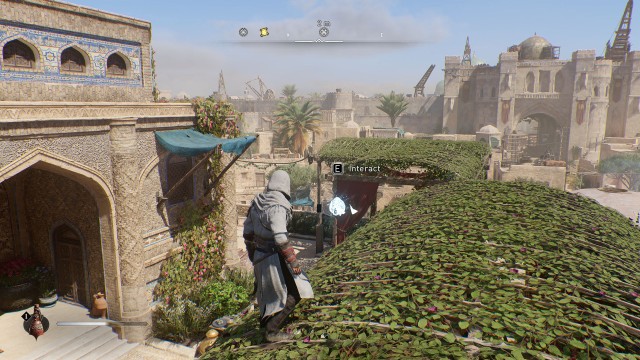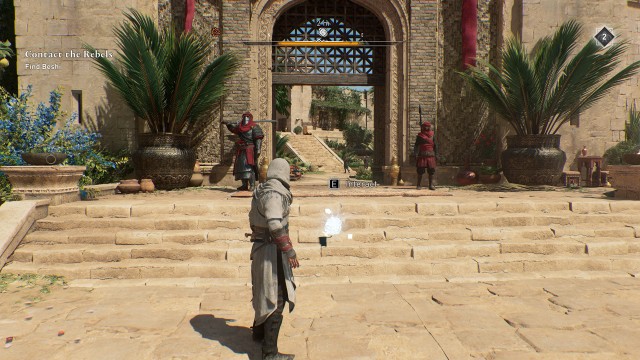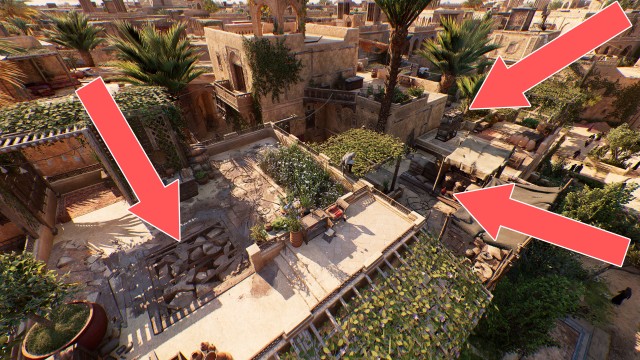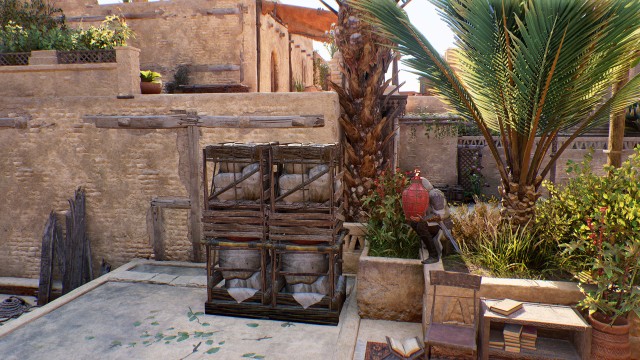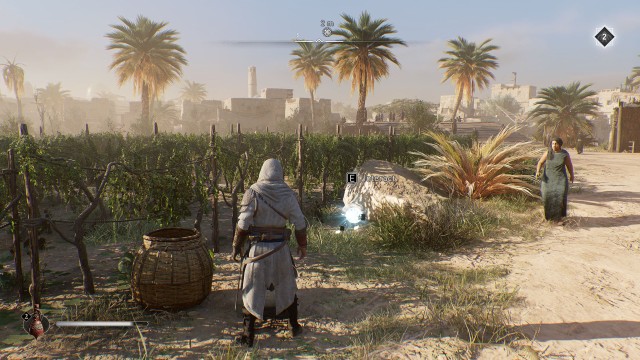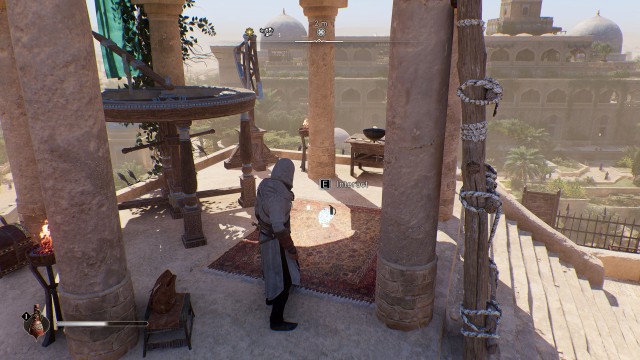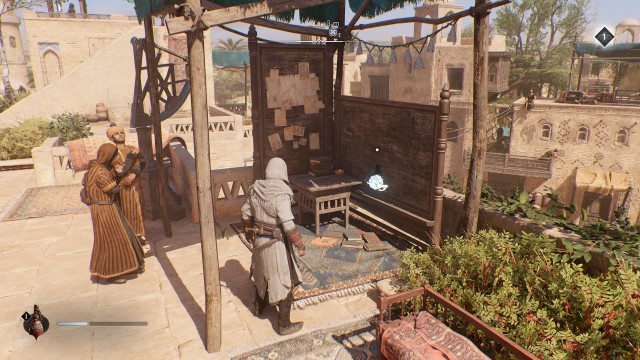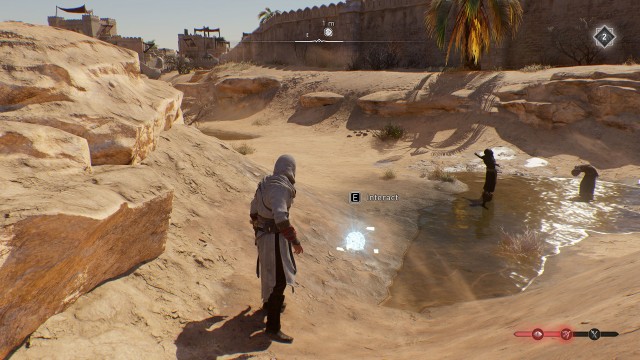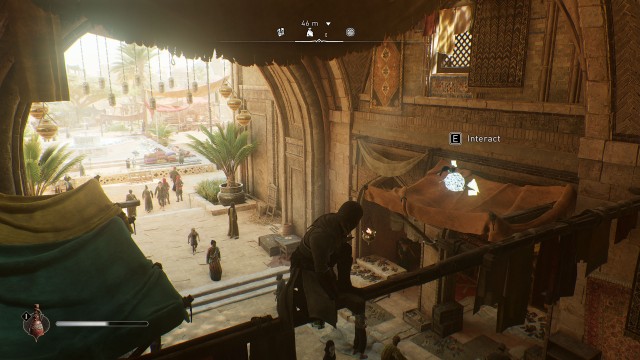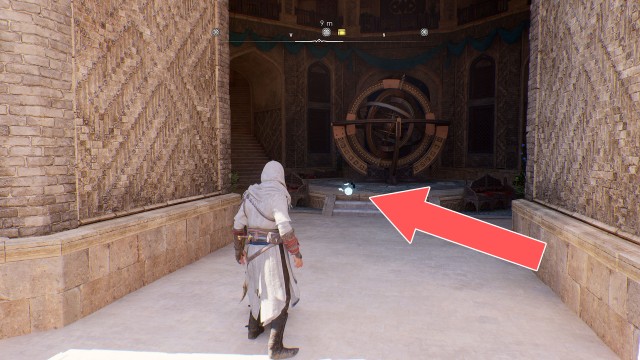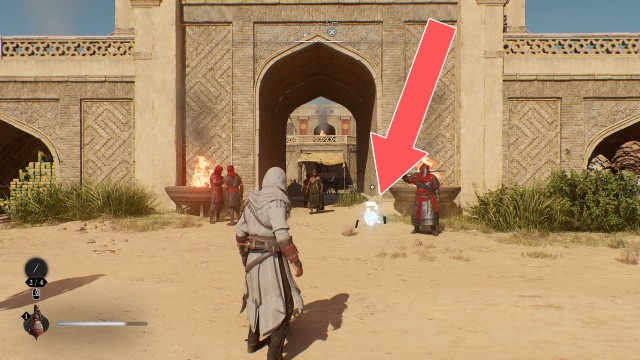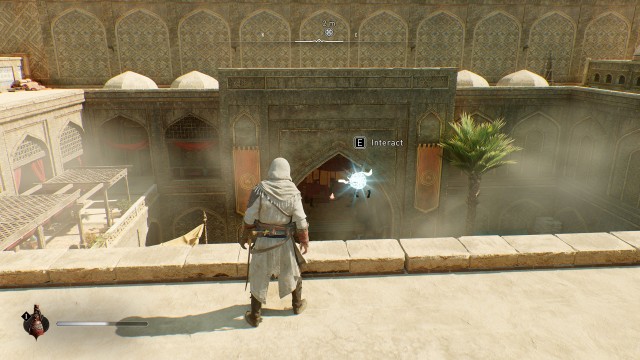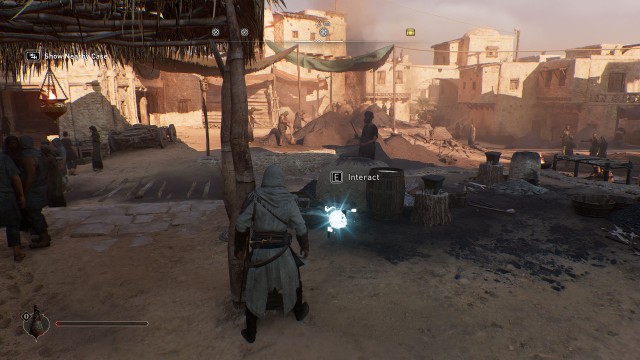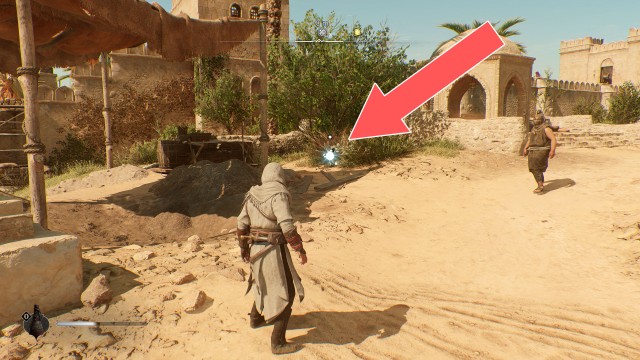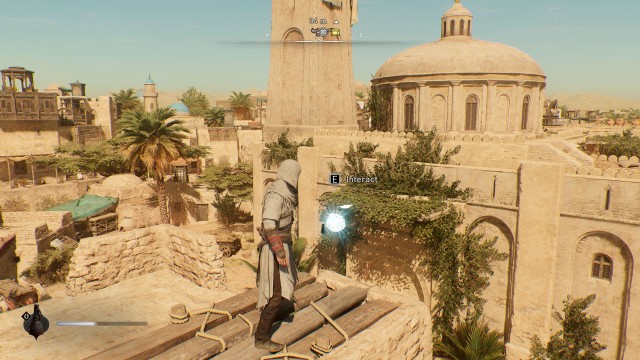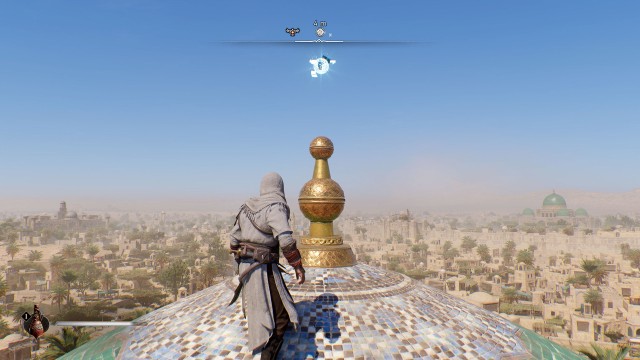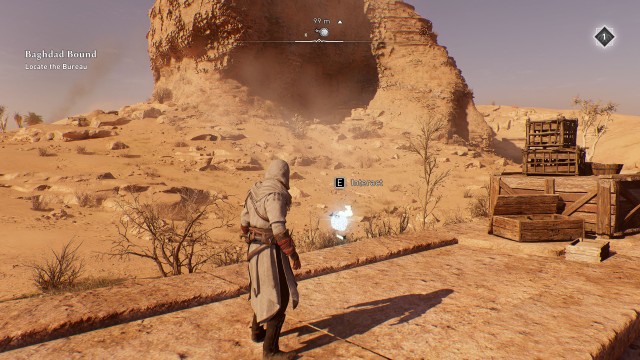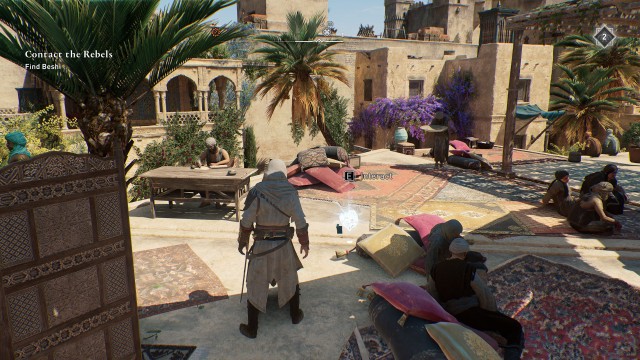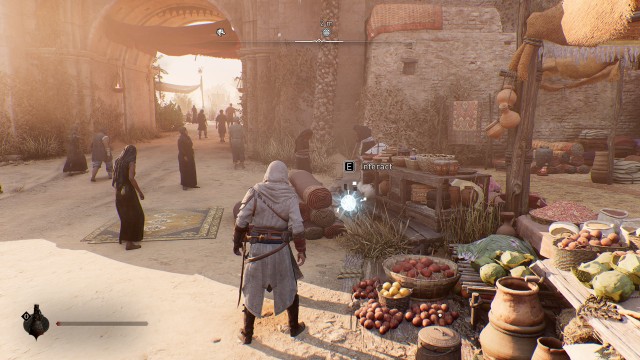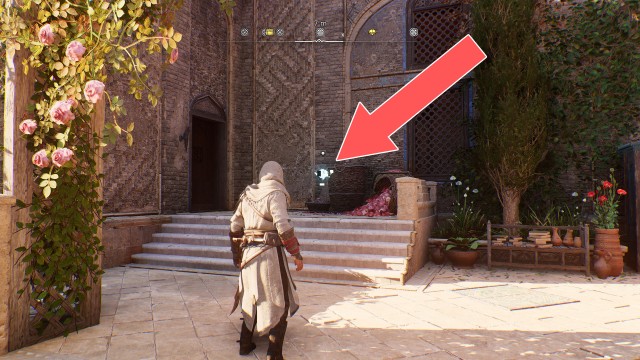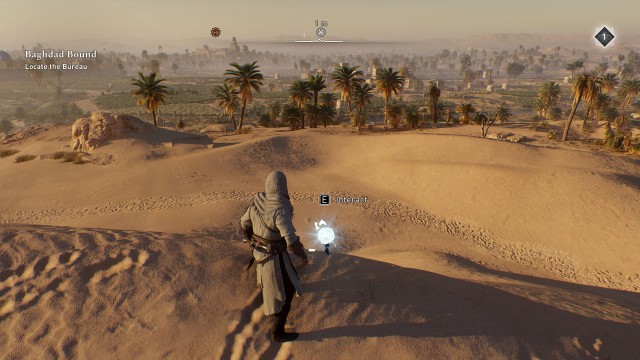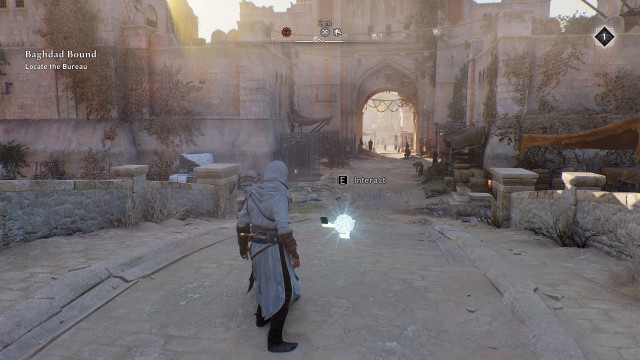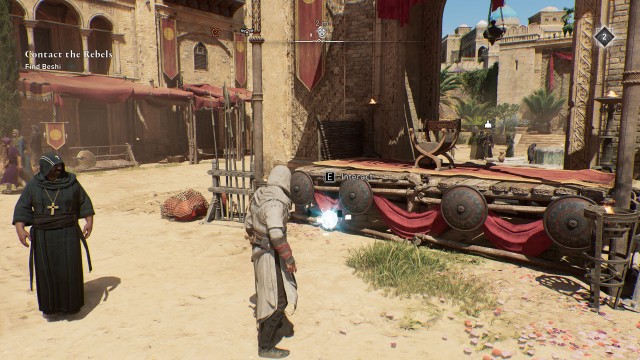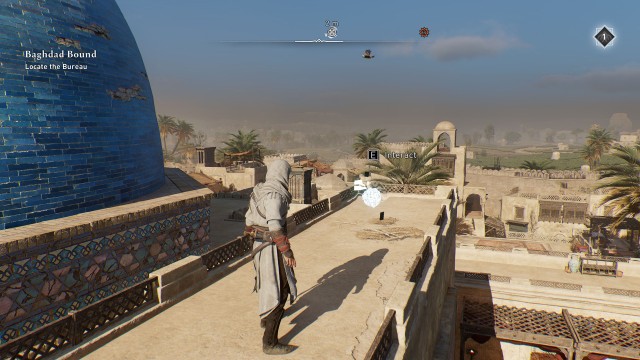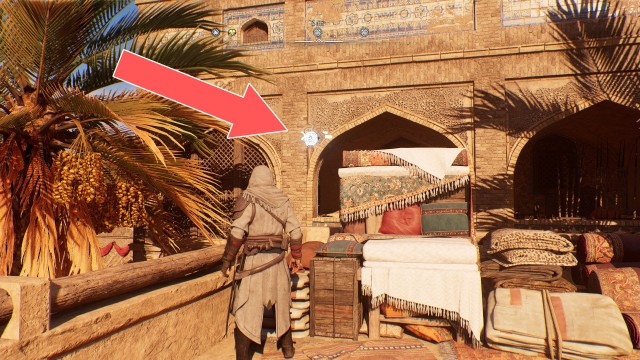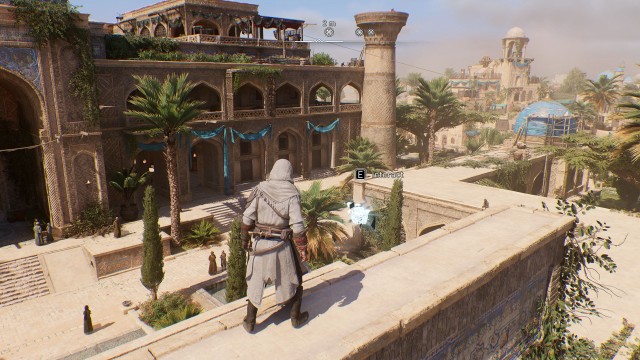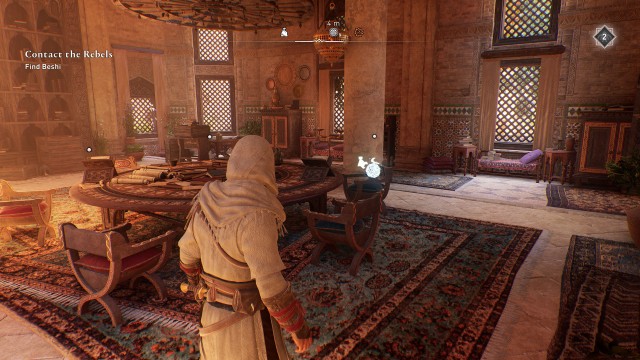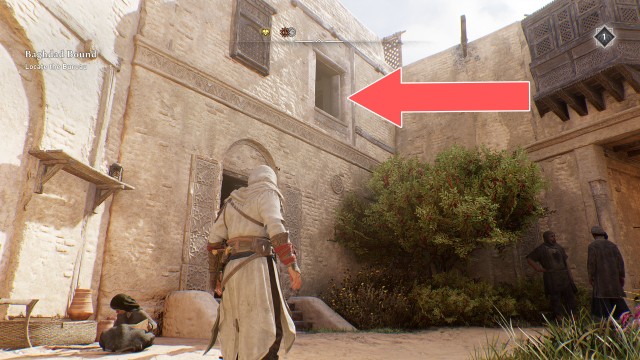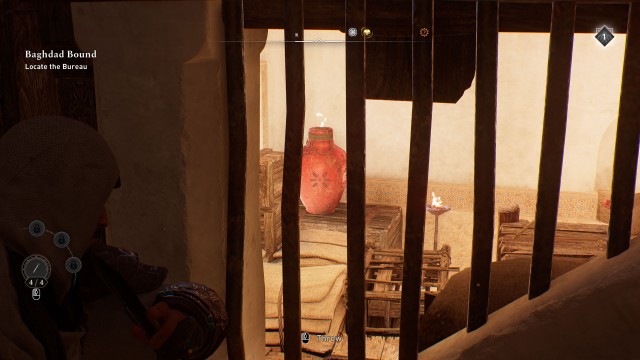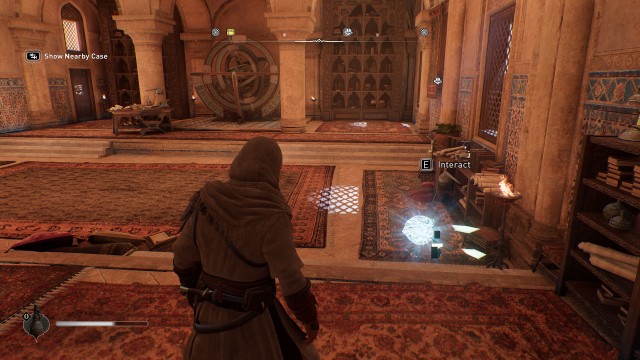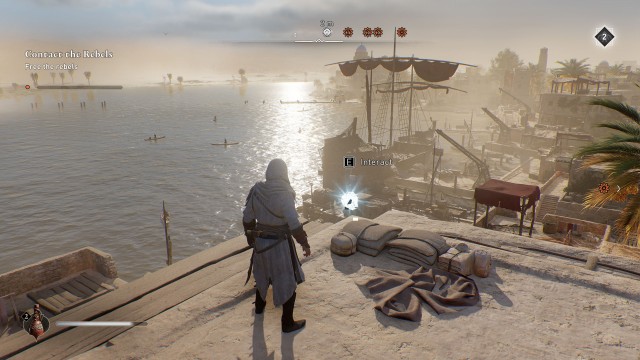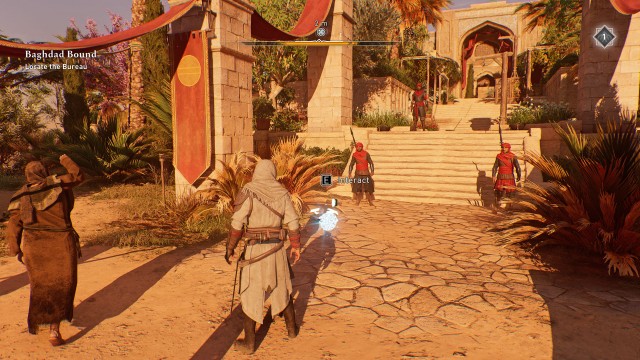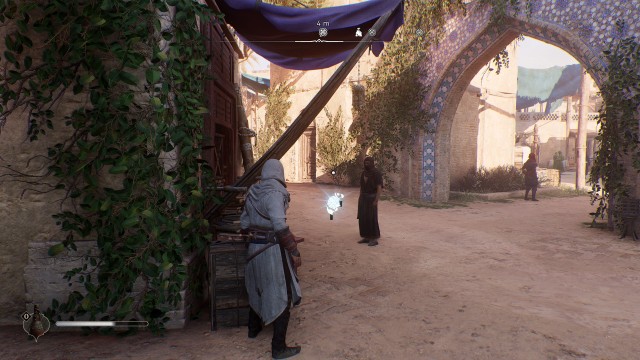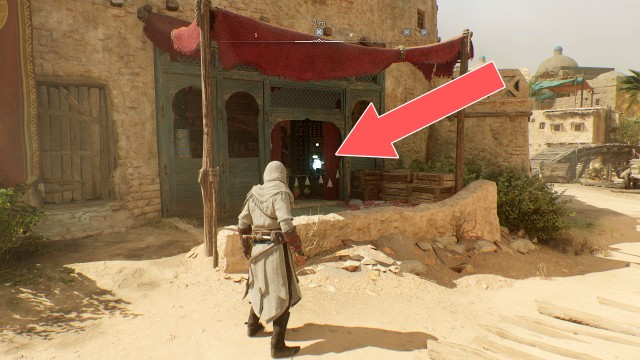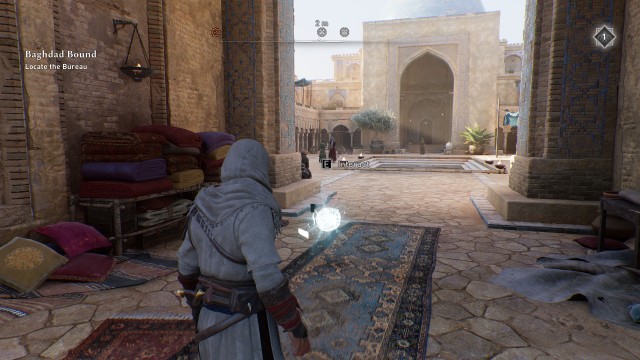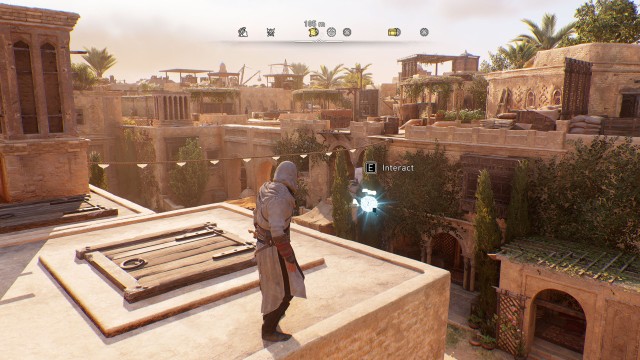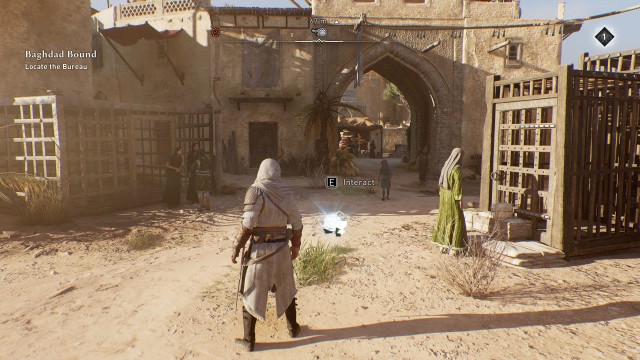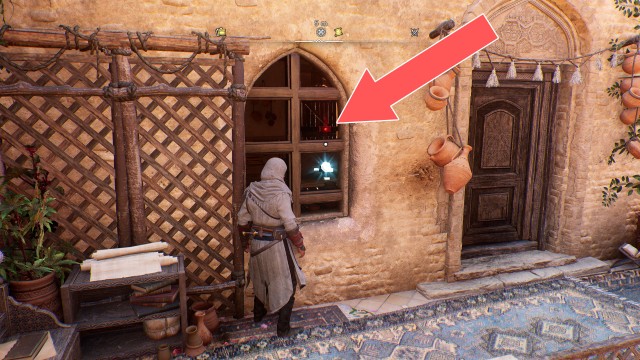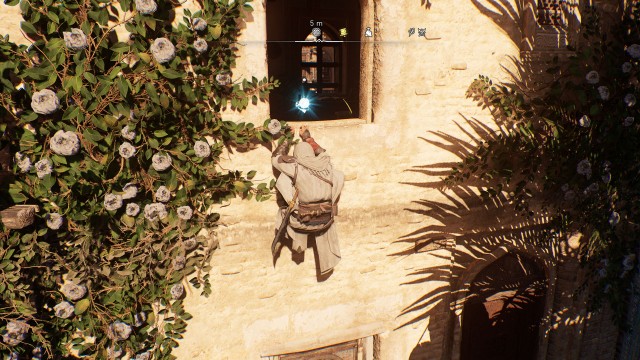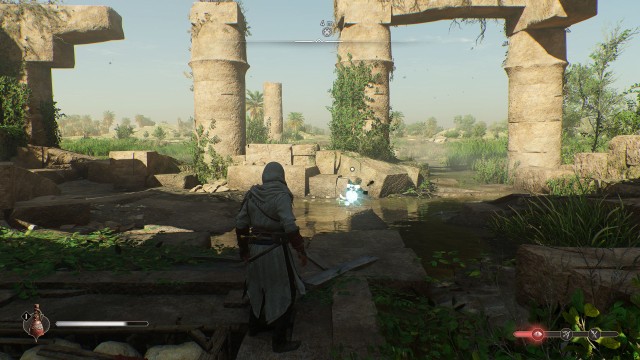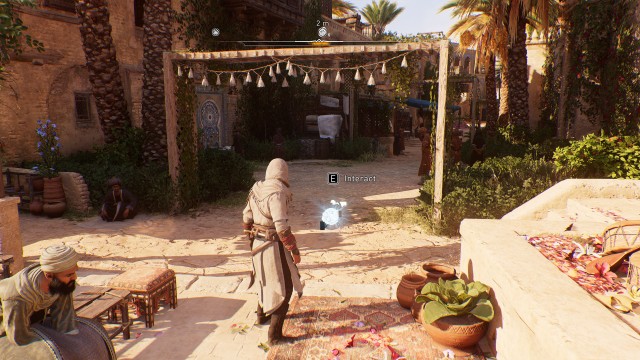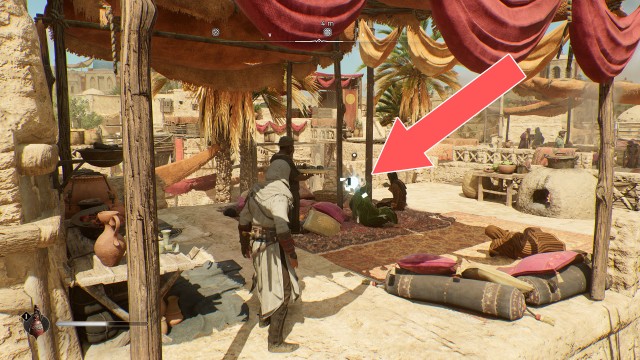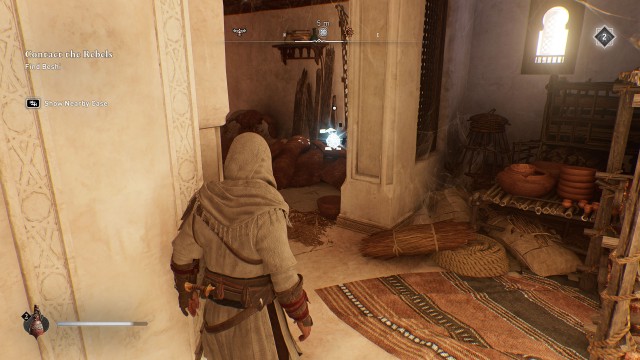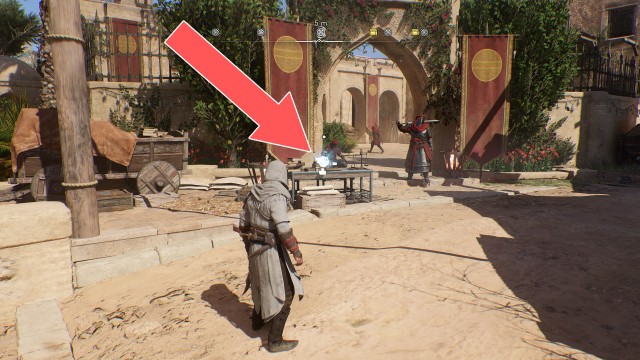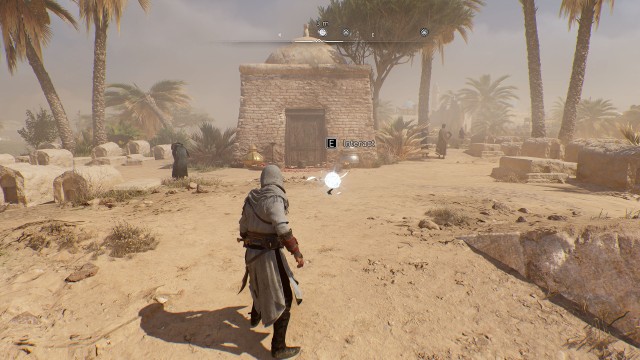All Historical Sites in Assassin's Creed Mirage
There are a total of 66 Historical Sites in Assassins's Creed Mirage. They are white, glowing spheres that you must interact with. When you do, a new entry will be added in your Codex in the History of Baghdad tab. There are a total of 5 categories of these entries:
- Art and Science (14 entries)
- Beliefs and Daily Life (12 entries)
- Court Life (12 entries)
- Economy (13 entries)
- Government (15 entries)
Index
- "Abbasid Style"
- A Difficult Succession
- Abbasid Army
- Abbasid Revolution
- Agriculture
- Al-Jahiz
- Alcohol Production and Consumption
- Animals at Court
- Arabic as a Cultural Unifier
- Astronomical Instruments
- Astronomy and Astrology
- Baghdad's Canals
- Baghdadi Exports
- Barid (Postal System)
- Bazaar
- Calculating the Earth's Circumference
- Caliph's Mother
- Camels
- Caravanserai
- Center of a World
- Ceramics and Lustrewares
- Death and Afterlife
- Dhimmi (Non-Muslims)
- Dome of the Ass (Donkey)
- Dur-Kurigalzu
- Education System
- Emporium of the World
- Eunuchs
- Expansion of Islam Through Trade
- Founding of Baghdad
- Gardens and Power
- Gates of Baghdad
- Ghilman (Servant Soldiers)
- Greeks Bearing Gifts
- Hajj (Pilgrimage to Mecca)
- Hammam
- Harem
- Healthcare
- House of Wisdom
- Judges and Judicial System
- Kalila and Dimna
- Majlis (Intellectual Salon)
- Maritime Trading
- Marriage and Divorce
- Muhtasib (Market Inspector)
- Other Palaces
- Papermaking
- Perfumes
- Pillars of Islam
- Powers of a Caliph
- Prisons
- Qiyan (Singing Girls)
- Scientific Method
- Seleucia-on-the-Tigris
- Shurta (Police)
- Silk Roads
- Singing and Poetry
- Slavery
- Table Manners
- Taxes
- Textiles
- The Abbasids … and their Rivals
- The Banu Musa Brothers
- The One Thousand and One Nights
- Translation Movement
- Zubaydah bint Ja'far
All known locations on the map Baghdad
 "Abbasid Style"▶ show the map ◀
"Abbasid Style"▶ show the map ◀
Category: Court Life
Abbasid artisans combined artistic techniques from ancient Greco-Roman and Persian traditions. They used these in new and creative ways that were widely adopted across the empire and created a distinctive Abbasid style.
One of its main characteristics was the use of abstracted scrolling and vegetal motifs, repeated again and again. These stylised motifs initially appeared on walls and stucco reliefs, but soon adorned dishes and clothes, as well as books. Historians have called it the "beveled" style, as it is characterized by symmetrical, abstract, vegetal forms with contours that are carved on a slant. First appearing in the first half of the ninth century in Samarra, this style spread throughout the empire in the course of the tenth century.
These motifs were used in combination with other kinds of decoration, for example painted frescos and glass mosaics. Abbasid architecture was also decorated with glazed ceramic tiles. In time, covering surfaces with colorful ceramic tiles became one of the most recognized features of Islamic architecture.
 A Difficult Succession▶ show the map ◀
A Difficult Succession▶ show the map ◀
Category: Government
At the death of a caliph, another one succeeded him immediately. But sometimes, deciding who that other would be was a complicated and dangerous task.
The Abbasid empire possessed clear rules about succession. Any male member of the ruling family could in theory become caliph, as long as he commanded the support of enough key elements of the government. After the passing of a ruler, a power struggle could therefore ensue between the various candidates and their partisans in the army or the administration. The harem, where the caliph's family and children lived and where he usually spent his last days, was another important factor in these scrambles.
The reigning caliph usually tried to nominate his successor. He could choose any of his male relatives but often favored one of his sons, if he had any. He then attempted to ensure that his chosen candidate would receive the support he needed by shoring up his position in the army and by having key members of the government and the Abbasid family take religious oaths to respect his decision. He would sometimes include the name of this chosen heir on coins struck by him. When the caliph had been a respected and powerful figure, these measures would usually suffice. But if not, or if his chosen successor was a divisive figure - a child, one of many brothers - nothing prevented the soldiers and the administrators from trying to push for another candidate. After the reign of al-Mutawakkil (r. 847-861), caliphal succession became more heavily contested than it had been in the early days of the dynasty, and it often led to coup attempts and sometimes civil war.
A coin issued during the reign of al-Muhtadi (r. 869-870) shows that successions did not always go according to plan. In addition to al-Muhtadi's name, this coin includes traces of the names of the previous caliph, al-Mu'tazz (r. 866-869), and the name of his son and then apparent heir, 'Abd Allah', who never became caliph.
 Abbasid Army▶ show the map ◀
Abbasid Army▶ show the map ◀
Category: Government
The Abbasid caliphs maintained an expansive professional army. Its main tasks were to defend rather than expand the borders of the already enormous empire and to ensure the continuous rule of the dynasty.
In keeping with the Abbasid empire's ethnic diversity, the caliphal army included regiments of various origins. In the eighth century, soldiers coming from Khurasan (Eastern Iran and Uzbekistan) who had supported the Abbasid's rise to power were the most common in the army, while other units included Arabs established in garrison cities and Zanj warriors from south-eastern Africa. In the ninth century, the Khurasani, considered too dangerous after their involvement in the 811-813 civil war, were replaced with ghilman regiments of Turkic, Slavic and Caucasian slave-soldiers.
This professional army amounted to tens of thousands of troops settled in mostly urban barracks all around the empire. Among them, a small majority were infantrymen equipped with spears, axes, composite bows and round helmets. The rest were an elite cavalry of chain-armored riders, armed with spears, axes, recurved swords and bows. In battle, they would mount devastating armored cavalry charges from behind an infantry screen. But most combat involved small border raids and sieges in which a few hundred Abbasid soldiers fought similarly-armed Byzantine, Tang, or North African counterparts.
In time, they revealed themselves to be just as adept at securing enormous financial and political advantages for their own gain as their Khurasani predecessors. When Caliph al-Mutawakkil tried to curb these advantages in 861, he was murdered by his own guards, opening a period of anarchy in which different factions within the military vied for influence and control, setting up and toppling caliphs as they went. The Abbasid empire never really managed to settle down after this chaotic time.
 Abbasid Revolution▶ show the map ◀
Abbasid Revolution▶ show the map ◀
Category: Government
The Abbasids came to power following a revolution (747-750) during which family members descended from Prophet Muhammad's uncle al-Abbas led Arab dissenters, largely composed of troops from Iraqi and Khurasani regiments, against the Umayyad caliph in Damascus. Of particular import was the military leader Abu Muslim, a general of either Iraqi or Persian descent, whose prowess on the battlefield eventually led to the toppling of the reigning dynasty.
The Umayyad dynasty had been caliphs since 661. As a result of the rapid expansion of the empire in the ensuing years, tensions arose between local peoples and Umayyad administrators. In the 740s, the Umayyad empire was significantly challenged by North African peoples. The massive number of troops sent to these Western lands in a failed attempt to reassert caliphal authority in the region aided the Abbasid revolution in the East.
The notables of the Eastern empire who were unhappy with the reigning dynasty, specifically their tax policies, indeed took advantage of the weakened Umayyad military position to attack its Syrian heartlands, the powerbase of the dynasty. With fewer troops available, the Umayyad center of Damascus soon fell to Abu Muslim's troops after the Battle of the Zab (Iraq) in 750. After the victory, the newly installed Abbasid caliphs struggled with what to do with the dangerously popular hero of the revolution. Eventually, to secure his power, Caliph al-Mansur (r. 754-775) had the troublesome Abu Muslim assassinated. The Abbasid dynasty, however, continued to rely on its Persian power base, a fact reflected both in the move of the capital to a more Eastern city, Baghdad, as well as in the choice of the top administrators of the empire.
 Agriculture▶ show the map ◀
Agriculture▶ show the map ◀
Category: Beliefs and Daily Life
The Umayyad and Abbasid periods corresponded with important advances in agriculture across the caliphal territories. They were facilitated by the size of the empire and a taxation system which favored irrigated lands. Even though this period has sometimes been called an agricultural "revolution", it mostly took the form of an expansion, intensification and spread of existing techniques.
Pre-existing infrastructures such as Roman or Persian aqueducts, canals and reservoirs were expanded and brought to previously arid lands. The use of agricultural devices such as watermills, animal-powered water lifts (saqiya) and water screws, known across the Mediterranean but sparsely used until then, became widespread. Crops common in the Eastern parts of the empire, such as sugar cane or bananas, were adapted to new environments from Egypt to Iberia and North Africa. The results were higher yields, larger cities … and plenty of citrus fruits!
These developments went together with a consolidation of land ownership into the hands of the elite. Large-scale irrigation works were lucrative but costly and could only be paid for by already wealthy landowners. The Abbasid period is therefore characterized by the expansion of huge estates to the detriment of smaller farmers, leading to widespread discontent.
 Al-Jahiz▶ show the map ◀
Al-Jahiz▶ show the map ◀
Category: Art and Science
Abu 'Uthman al-Jahiz (the bug-eyed) was a prolific ninth-century writer considered to be one of the finest authors composing in Arabic of all time. Born into the poor family of a black cameleer, his witty writing style attracted the attention and patronage of Baghdad's high society, which he proceeded to delight and satirize in more than a hundred and twenty books.
Al-Jahiz's specialty was composing works of adab. This literary corpus sought to represent, through eclectic examples, the mix of good manners and high culture an ambitious government official, court hanger-on, or scribe was expected to possess in order to shine in elite circles - for example, elements of history and poetry, famous rhetorical retorts, jokes, anecdotes, and so forth. As such, al-Jahiz's books touched upon many different subjects, making still-relevant observations. In his Kitab al-Hayawan (Book of Animals) for instance, he describes the more than 350 species of animals known at the time and remarks on how environmental factors create new characteristics in organisms that are passed to the offspring of surviving animals.
Besides selling fish during his childhood, his only known professional activity was to write and appear in intellectual salons (majlis). Hence, he is one of the first professional writers in history. According to legend, even his death was linked to his love of literature. While rummaging through his vast collection of books, he is said to have been crushed by a collapsing bookshelf!
 Alcohol Production and Consumption▶ show the map ◀
Alcohol Production and Consumption▶ show the map ◀
Category: Beliefs and Daily Life
Islamic law prohibited alcohol consumption because it altered the mind and caused wrongful behavior. It was therefore considered a major sin. However, Abbasid religious scholars discussed the precise scope of this ban. Some interpreted it as a full ban on all alcohol consumption, while others limited it to excessive consumption, public drunkenness or only to alcohol made from fruits (grapes, dates, etc.), as opposed to mead or beer for example.
In practice, alcohol was nonetheless consumed, as proved by numerous accounts and drinking vessels - including one pictured here whose inscription reads, "Drink! Blessings from God to the owner of the goblet". Alcohol was even a major topic of poetry in a genre of literary works called the khamriyyat, which was dedicated to the praise of wine, intoxication, and the pleasures of the table. These accounts establish that alcohol was consumed at every level of society, including by clergymen and high-level officials. It seems that the issue of alcohol and its prohibition was possibly more focused on public drunkenness (which could lead to police intervention) while there was probably a higher degree of tolerance for drinking in private areas.
The main producers of alcohol seem to have been the non-Muslim members of the Abbasid society. Most of them did not follow the same religious restrictions and brewed or vinified what they consumed. Monasteries were among the most famous winemakers. They were forbidden to sell any of it to their Muslim neighbors, but many stories of inebriated visits to the monks and even bottles sporting representations of priests seem to indicate that the law was not followed by everybody.
 Animals at Court▶ show the map ◀
Animals at Court▶ show the map ◀
Category: Court Life
In addition to its many human residents, the caliphal court was home to numerous animals. Coming from every corner of the empire and featuring in public as well as private settings, they symbolized the caliphs' power and generosity. Enthralled ambassadors were received in the capital by silk-clad elephants while shiny thoroughbred horses were ridden by the caliph in his public appearances. Zubaydah, wife of Caliph Harun al-Rashid (r. 786-809), even had a pet monkey which she dressed as a general. But no animal featured as heavily at court as the hunting falcons of the caliphal falconry grounds.
Since antiquity, falcons have been linked to gods and kings in the Persian culture which influenced the Abbasid court. Through their graceful flight and deadly efficiency, they were associated with various heavenly beings protecting good and resisting evil. Seeing them on the eve of battle or using their feathers on weapons was thought to bring supernatural protection. Training them was therefore a way of harnessing divine help and cultivating legitimacy.
Caliphs also used falcons to hunt, as well as in public demonstrations of skill. They devoted huge resources to their acquisition and maintenance. Elaborate hunting expeditions provided full-time employment to a vast group of organizers, trainers, veterinarians and assistants working under the supervision of the al-Bayzar (master falconer), one of the main officers of the court. Professional catchers, who picked up eggs and chicks in their nests, as well as merchants dealing in sporting birds from all over the world, also profited from this costly habit. Falcons even featured in poems and training guides. One of the most famous guides, Kitab al-Mutawakkili, was written for Caliph al-Mutawakkil himself, an avid hunter.
 Arabic as a Cultural Unifier▶ show the map ◀
Arabic as a Cultural Unifier▶ show the map ◀
Category: Art and Science
Long a linguistic presence in the Arabian Peninsula and the Eastern Mediterranean, Arabic expanded all over the empire through the conquests of the seventh and eighth centuries and the establishment of Arabic-speaking diasporas and colonies. Through a combination of deliberate policies and peer pressure, it eventually became the lingua franca of much of the territory stretching from the Pyrenees to the Himalayas.
Many factors explain the expansion and popularity of Arabic. First and foremost, it was the liturgical language of Islam and its mastery was necessary to read and understand the Quran and other religious texts. The slow and steady spread of this religion across the empire therefore led to the adoption of its sacred language by the new converts. Moreover, by the 720s, much of the administration of the empire had become Arabicized. Those wishing to advance socially and politically therefore found it well worth their effort to learn Arabic. Finally, as something akin to a common tongue, it became the language of trade, arts and sciences between the various peoples of the empire.
Despite being the dominant language of the empire, Arabic was not the only language spoken in it. Among other languages spoken were Persian in Iran, Syriac in Syria, Berber in North Africa, Coptic in Egypt and Hebrew wherever there was a Jewish community. It is probable that most inhabitants of a cosmopolitan city like Baghdad spoke a little bit of multiple languages.
 Astronomical Instruments▶ show the map ◀
Astronomical Instruments▶ show the map ◀
Category: Art and Science
Long before the invention of the telescope, ancient civilizations developed ways to chart the heavens. Building on their knowledge, Abbasid scholars improved their methods and created instruments still in use today.
The most important, and perhaps the most long-lived, was the astrolabe. It was created in the third century BCE by Greek astronomers as a way to "hold the universe in the palm of your hand". An astrolabe is indeed an engraved circle representing the stars rotating (in the Pre-Copernican geocentric thinking of the time) around the Earth. A circle in the middle of an astrolabe represents the user, set on a line that represents the horizon. Various points indicate known stars. From the eighth century onwards, Abbasid astronomers improved the astrolabe by adding elements for deciphering the date and hour of the day, or other engraved disks pointing to the stars that could be seen at different latitudes for use by travellers.
This apparatus had many uses: determining the time of rising and setting of the sun and stars, calculating the height of buildings or the length of river crossings, and finding prayer time or the direction of Mecca. Abbasid astronomers found hundreds, if not thousands, of different ways to use this handy instrument!
 Astronomy and Astrology▶ show the map ◀
Astronomy and Astrology▶ show the map ◀
Category: Art and Science
It is said that if you are ever lost in a desert, looking at the stars will help you steer your way to safety. Like their Umayyad predecessors, the Abbasid caliphs certainly believed in the usefulness of stargazing and funded the construction of observatories and the translation of many Greek, Indian and Persian astronomical works. One of the most important Arabic works of astronomy from this period was the 10th century Treatise on the Fixed Stars (a commentary on Ptolemy's Almagest) of 'Abd al-Rahman al-Sufi (903-986). Illustrated with depictions of stars and constellations known from classical antiquity, it was widely copied and used for centuries after. Al-Sufi is credited as the first astronomer on record to have observed the Andromeda Galaxy!
Abbasid astronomers were not only interested in the science of astronomy, they were also interested in its practical applications, especially astrology, the art of determining auspicious days for activities. For instance, al-Mansur sought the help of astrologers in choosing where and when to build Baghdad.
Attempting to decipher the future in such a way required an extensive understanding of the movements of the heavenly bodies. Time-consuming observations and elaborate calculations were needed to create astronomical tables that described the precise positions of the moon, the sun and the five known planets - Mercury, Venus, Mars, Saturn and Jupiter. Special events such as floods and invasions were noted next to them and could be used to suggest causality between the stars and human life. Astronomy was therefore seen as a tool for astrology, but it could also be used on its own for calculating prayer times or land surveying. Whatever their final objective, Abbasid-era astronomers contributed enormously to astronomical knowledge, and were responsible for the discovery of many stars (Altair, Aldebaran) and the coinage of many astronomical terms (azimuth, nadir) that are still used today.
 Baghdad's Canals▶ show the map ◀
Baghdad's Canals▶ show the map ◀
Category: Beliefs and Daily Life
In Baghdad's dry climate , the city's water supply depended on a dense network of natural and artificial waterways starting, of course, with the Tigris and its tributary the Diyala river. Added to these was a system of canals whose construction could be traced over a millennia, and which was restored and expanded by the Umayyads and Abbasids. Around the city, this network was incredibly dense and went from large navigable canals to very narrow trenches. Some of the water was also provided by canals coming from the Euphrates to the west.
This massive system fulfilled multiple needs. It provided the city with the water necessary for daily consumption, hygiene, a sewer system, etc. It played a crucial role in irrigating the cultivated lands around Baghdad, turning them into the breadbasket of the city and its growing suburbs. Linked by canals, the Tigris and the Euphrates were also essential communication and trading routes of worldwide importance, used to bring goods and people from the Indian Ocean to the Mediterranean region. Finally, the water system could easily turn into a useful defensive feature when needed. Most of the bridges over Baghdad were in fact on wooden pontoons which could be disconnected or even destroyed in case of attacks.
This useful system came at a cost. Maintaining it was extremely labor-intensive, demanding ever-increasing efforts from a large number of free and enslaved workers.
 Baghdadi Exports▶ show the map ◀
Baghdadi Exports▶ show the map ◀
Category: Economy
From Northern Europe to East Asia, Abbasid craftsmanship was coveted and sometimes even copied by emperors and monks alike. Numerous objects created in the empire have been found outside of it. Their abundance testifies to the importance of commercial and cross-cultural exchanges at the time.
Coins made in Abbasid mints figure preeminently in these finds. Golden dinars and silver dirhams of stable weight and value were struck with regularity in Baghdad and other cities. Merchants' confidence in them was such that they were used well beyond the empire's borders, especially in Northern Europe where few organized power centers produced their own coins. One Anglo-Saxon king, Offa of Mercia (r. 757-796 ) went even further than using them. He created golden coins that simply copied dinars struck by Caliph al-Mansur (r. 754-775) , complete with an Arabic inscription attesting that "there is no God but God alone". One has been found in Rome and was probably offered by Offa to the Pope. Quite an ironic twist.
Glasswork was another popular Baghdadi export. Small and light, glass pieces could be carried far away without much effort. Several examples have been uncovered in the Famen temple of Northern China and in royal burial sites from the late Silla period in Korea. One tiny black glass seal inscribed with Arabic script was even inlaid in the middle of a cross found in the Ballycottin bogs of Ireland. It might have been added there to take advantage of the magical protection some Christians accorded to Arabic writing at the time.
 Barid (Postal System)▶ show the map ◀
Barid (Postal System)▶ show the map ◀
Category: Government
Caliph al-Mansur believed that the Abbasid state stood on four pillars: clerics that feared God, guards that helped the weak, honest tax collectors … and the barid, an extensive system of couriers and spies who ensured everyone else's loyalty!
Postal routes set up and paid for by the state have existed in one form or another in the Middle East since the Achaemenid Empire's Royal Road. It was an essential tool for ruling an empire stretching from Morocco to China. The Abbasids took over this system in 750 and expanded upon it in the following decades.
Their barid was made up of postal routes established to expedite the reception of news and the issuing of orders to the provinces. 930 small stations, 8 to 10 kilometers apart, were prepared and staffed with runners, riders and horses ready to go at a moment's notice. Food, water, fodder, and everything needed by couriers were readily available to ensure the speedy transfer of information.
The head of the system was the sahib al-barid (master of letters). His job was to report the important affairs to the caliph, to carry out his orders and to supervise the work of the empire's administrators. As such, he was respected by his colleagues as a man who could sway their whole destiny with a single word.
 Bazaar▶ show the map ◀
Bazaar▶ show the map ◀
Category: Economy
The Persian bazaar or the Arabic suq was a public market consisting of multiple covered and uncovered stalls. It was the beating heart of any Abbasid city. There, one found both staples of everyday life and exotic delicacies, along with local merchants and travelers from faraway lands.
Baghdad's great bazaar served as a permanent public space where men and women could gather, socialize, and purchase daily food, basic materials and other useful objects. In its galleries, they would find hard-working craftspeople like jewelers or shoemakers, but also goods brought from every corner of the empire by caravans. Market inspectors were also a common sight, there to ensure product quality, the use of accurate weight scales, and the full payment of all caliphal fees and customs.
In general, markets were organized by product, each area dedicated to specific commodities. The most precious were sold in a specific part of the bazaar, the qaysariyya. In Baghdad, the most important of these was the Shahar Suq (the "Four Markets"), which had areas dedicated to the sale of horses, fine fabrics, and books, in addition to one for the sale of peoples into slavery. The colorful stalls of vendors selling fabrics made it one of the most glamorous areas of the market, described as a marvel by many travelers. For the Baghdadis wealthy enough to acquire them, Indian muslin, Chinese silk, and embroidered cotton from Samarkand or Cordoba were readily available.
 Calculating the Earth's Circumference▶ show the map ◀
Calculating the Earth's Circumference▶ show the map ◀
Category: Art and Science
In Abbasid Baghdad, every scholar knew that the Earth was spherical. They knew it because they had read about it in translated Ancient Greek manuscripts, most importantly Ptolemy's Almagest, which was translated by the great Abbasid astronomer al-Sufi. They also knew it because they had used simple geometric concepts and trigonometric equations to calculate its circumference.
Around 240 BCE, a Greek mathematician named Eratosthenes had used shadows projected by wooden rods to calculate that two cities were separated by 7 degrees, or 1/50th of a sphere. He then multiplied the distance between these two points by 50 to get the size of the Earth, within 5% of modern calculations. Sometime around 830, a team of 70 mathematicians, including the famous mathematician al-Khwarizmi (780-850) recreated his experiment. Improving on their predecessor's method, they tried to diminish the risk of error by using points separated by a single degree. Traveling from Baghdad to the surrounding desert and trying to follow a North-South road, they stopped when they reached a point where the elevation of the Pole star had changed by a degree. Their calculations were similar to those of Eratosthenes. Later, another scientist, al-Biruni (973-1050), got even better results by using a mountain as his measuring rod!
Both expeditions were motivated in part by the desire to know the extent of their territory compared to their rivals, and by Islam's requirement to pray facing Mecca's Kaaba, no matter your position in the world. A proof that religious belief and scientific pursuits don't always come into conflict.
 Caliph's Mother▶ show the map ◀
Caliph's Mother▶ show the map ◀
Category: Court Life
The head of the harem was the mother of the caliph who ruled over it as a sort of personal court. Through her direct relation to her son, she could exert considerable control over the empire and act as an essential political player.
Most were originally enslaved concubines brought from outside of the Muslim world. After having borne a son to the caliph, they could acquire the highly sought-after title of umm walad ("mother of the child/heir"). Though rare, in some cases she could even attain the status of a legal wife, even though the stigma of her enslavement remained and could always be invoked. For instance, al-Khayzuran, the wife of Caliph al-Mahdi and mother of Harun al-Rashid, was originally an enslaved Yemeni concubine. A coin bearing the name of her palace complex suggests that she acted as de facto ruler after the death of her husband.
Indeed, becoming the mother of the caliph would bring her considerable power and wealth. From the heart of the caliphal palace, umm walads used their network of servants, eunuchs, and entertainers to structure charitable foundations, fund important works of architecture and infrastructure, manage their own properties, and treat with potential political allies. But attaining this status implied political struggles.
After giving birth to her son, an umm walad's priority became convincing the caliph to name her child as official heir. This put her on a collision course with other women whose sons could claim the caliphal title, and their supporting factions. Unruly or rebellious brothers could be dealt with by assigning them to posts in distant territories. While fratricide was frowned upon as impious and therefore inappropriate for a ruler in the Abbasid age, conspiring to take the throne could in rare cases lead to execution.
 Camels▶ show the map ◀
Camels▶ show the map ◀
Category: Economy
While camels are a mandatory cliché of any depiction of the Islamic world, the so-called "desert ships" have long been not only an iconic but also a crucial means of transport across Eurasia.
Camels were already a well-known method of travel during antiquity, used from Morocco to China. Their wide padded feet helped them keep their balance on any path, while their fatty humps provided them with energy in regions where food was scarce. Moreover, the camels could eat almost any plant, even thorny ones, and turn them into milk or meat for hungry caravanners. They also showed great resistance to extreme temperatures, with dromedaries (one-hump) more desert-resistant and Bactrian camels (two-humps) more tolerant to cold and high altitudes. They could carry much heavier loads than horses or donkeys, making them perfect pack animals. Their efficiency and flexibility had a clear effect on the economic wealth of the Abbasid empire, boosting its trade and facilitating travels all across its huge expanse. They were also useful in warfare, as they could run surprisingly fast!
The preferential use of camels had important consequences on the landscape and the city planning of the empire. Caliphs did not need to maintain an extensive paved road network, as camels did not need one. Since camels made wheeled carts virtually unnecessary, Abbasid cities could also maintain narrower roads. The tall buildings that lined these narrow roads kept the city in shade, meaning that the ambient temperature inside cities was several degrees lower than in surrounding open areas.
 Caravanserai▶ show the map ◀
Caravanserai▶ show the map ◀
Category: Economy
The Caravanserai was a "palace (saray in Persian) for groups of people (karvan)". More roadside inn than palace, it offered a safe place and varying levels of comfort to merchants, pilgrims and travelers recovering after a day's journey along the empire's roads.
Caravanserais were commonly constructed by the caliphs, their relatives and members of the local elite to display their piety and generosity. Hundreds of them dotted the empire, especially its Iranian-Iraqi core. They were built about 30 kilometers apart, the distance a man and his pack animal could be expected to travel each day. In them, travelers could find safety for the night, exchange goods, share news and pay taxes to ensure the maintenance of the facility.
No two caravanserais were alike. Even if most of them featured a large courtyard surrounded by a wall, both their physical appearance and available facilities varied widely from one to the other. In plains and deserts, the courtyard would be open and the walls made of dried bricks, while in the mountains, a fully roofed area would keep out rain and snow. The most well-appointed had a cistern, stables, a prayer space, guards, and rooms for guests. But most were simple roofed galleries without any of these niceties! While no caravanserais survive from this period, the so-called "desert palaces" of the Umayyads, like Qasr al-Hayr al-Sharqi, may have fulfilled a similar role.
 Center of a World▶ show the map ◀
Center of a World▶ show the map ◀
Category: Economy
In the ninth century, hundreds of thousands of people called Baghdad home. They worshipped many different gods, spoke many different languages and came from many different places. What attracted them was the reputation of Baghdad as a global commercial, intellectual, political and financial hub.
The city was linked to various regions and other cities around the world through a network of maritime and land routes known as "the Silk Road". Chinese merchants would reach Baghdad's port through the Indian Ocean and the Tigris River and meet Byzantine monks, Andalusi intellectuals, and Scandinavian adventurers coming from the Mediterranean Sea through the Euphrates River. What attracted them was the splendor and fame of the Abbasid capital and its court. Fueled by the resources of the vast empire brought to the city by the centralized caliphal administration, the court could buy any exotic products brought to Baghdad and patronized the production of incredibly delicate crafts that the rich all over the world coveted.
Like other premodern empires, the Abbasids recognized and employed talents from groups irrespective of religious or ethnic background. They made sure to award positions to whoever proved the most competent no matter his or her origins, mixing Persian Muslim astronomers with Syriac Christian translators and Jewish physicians.
All this made ninth-century Baghdad the great multicultural center of its time.
 Ceramics and Lustrewares▶ show the map ◀
Ceramics and Lustrewares▶ show the map ◀
Category: Economy
To accommodate the court's taste for elaborate luxuries, Iraqi potters experimented with new techniques, colors and styles in their creations. Their most important innovation was luster painting, which created a glittering effect so popular that it went on to be exported and copied everywhere from Portugal to Thailand.
One of the main sources of inspiration for Abbasid artisans were Chinese wares, especially white and blue porcelain brought to Iraq by boat in the ninth century. Their hardness, translucency and whiteness were at the time revolutionary in the region, and they enjoyed immense prestige among the wealthy. Initially, Iraqi potters attempted to meet this demand for Chinese imports by direct imitation, coating their usual brown earthenware in a white tin or lead-based substance before adding decorative colored glazes. However, Abbasid potters soon began attempting modifications to produce their own style, adding motifs inspired by local vegetation such as palm trees and meadow plants.
More importantly, Iraqi potters started to experiment with an entirely new technique, luster painting. This involved preparing a special overglaze by blending silver or copper oxides with a carrier such as ochre, and then mixing this fine powder with vinegar and gum. This mix was painted onto an already glazed pot and fired in a special reduced oxygen kiln. If done right, this complicated and costly technique created an incredible metallic sheen. The result was almost alchemical, with simple earth appearing to have been transformed into silver or gold.
 Death and Afterlife▶ show the map ◀
Death and Afterlife▶ show the map ◀
Category: Beliefs and Daily Life
In time, rituals inspired by Prophet Muhammad's life started to coalesce into a distinctive Islamic burial rite practiced all over the empire. A unique element was a relatively short mourning period of only a few hours. In this small amount of time, the body was washed in houses or mosques an uneven number of times with perfumed water. Depending on the financial resources of the mourners, the deceased person was dressed with either a dedicated mourning shroud or a clean cloth, wrapped an odd number of times, with the best available cloth used for the head. Finally, the body was carried to a cemetery in a procession bringing together family members, friends and neighbors. They laid the deceased to rest on their side, facing Mecca and the eventual judgment of God. The prominence of odd numbers in these practices were related to their signifying the oneness of God in Islamic theology.
Every one of these steps was linked to the perception of the afterlife. Those who passed away were believed to be awaiting a Day of Judgment, in which they would appear in the state in which they were buried. Then would be decided their eternal fate, either in Jannah, the final abode of the righteous or Heaven, or in Jahannam, the place of punishment for evildoers or Hell. Of course, this view of death as transitional did not prevent feelings of sadness: Abbasid cemeteries were full of family members visiting their dead loved ones, offering poems, prayers and small tokens of affection or memorabilia.
 Dhimmi (Non-Muslims)▶ show the map ◀
Dhimmi (Non-Muslims)▶ show the map ◀
Category: Beliefs and Daily Life
The term dhimma means "obligation" and was used in Abbasid times to refer to conquered peoples under a specific tax obligation to the government. People of the dhimma, called dhimmis, were often descendants of the Christians, Jews, Zoroastrians and others whose communities came under the control of the Abbasid Empire. They made up a large part of the empire's population.
Their status was justified by Quranic verses distinguishing between monotheistic non-Muslims and polytheistic "pagans". The latter had to be converted, while the former were entitled to their life, their property, and their freedom of religion in exchange for their loyalty and the payment of a tax. Tax receipts like this one were therefore very important to prove their status.
Many dhimmis played important and public roles in the empire. For instance, Syrian Christians played a significant role in translation initiatives. The most famous translator of the time was Hunayn ibn Ishaq, a Nestorian Christian physician. Having mastered Arabic, Syriac, Greek and Persian, he translated more than a hundred works, specializing in medical and scientific texts. For this he was paid handsomely, as much as some provincial governors! Other dhimmis served the Abbasid caliphs as physicians, astronomers, tax collectors and even viziers.
This policy was born out of self-interest for the caliphs: during the Islamic expansion of the seventh and eighth centuries, very few Muslims had the administrative know-how to ensure the continuous day-to-day management of the cities they were conquering, and letting the local elites keep some form of power facilitated their surrender immensely. During the Abbasid times, this still held true: when Caliph al-Mansur (r. 754-775) attempted to remove dhimmis from his administration, he was soon compelled to return them to their positions due to their expertise.
 Dome of the Ass (Donkey)▶ show the map ◀
Dome of the Ass (Donkey)▶ show the map ◀
Category: Beliefs and Daily Life
"Fetch me my noble … donkey?" As hard as it might be to believe, in the Abbasid period the donkey was regarded as one of the noblest creatures, fit for royalty, and as some legends and painted manuscripts depict, for the Prophet Muhammad himself. This helps to explain the unconventional name of this building.
The Dome of the Ass (Qubbat al-Himar) was built by Caliph al-Muktafi bi-llah (r. 902-908) in the southwestern corner of his palace. It is described in medieval sources as very great in height, with a spiral stair at such an easy gradient that the caliph could ride to the top on a donkey trained to walk at an easy gait. In order for the slope to be gentle enough for a donkey to climb to its apex with little strain, this building must have been quite large and tall.
The dome's name was also very important in another way. The Year of the Donkey was especially significant for the Abbasid Empire, as it was during this year that the revolution through which they acquired power took place. The Year of the Donkey is also present in some Islamic beliefs related to the Day of Judgment. The Qubbat al-Himar had therefore a significant name that contemporaries would have understood as noble, royal, and heavenly. This symbolic power continued for centuries, as shown by this star-shaped tile of the later Ilkhanid period (1256-1353).
 Dur-Kurigalzu▶ show the map ◀
Dur-Kurigalzu▶ show the map ◀
Category: Government
On the outskirts of Baghdad stands what looks at first sight like a hill battered by the winds. On closer inspection, however, the mound is made of baked bricks which form a 60-meter high structure. According to an inscription found on one of them, they were placed by King Kurigalzu II in the 14th century BCE. It is the last standing building of the former capital of the Kassite empire, Dur-Kurigalzu (the fortress of Kurigalzu).
The Kassites ruled over central and southern Mesopotamia (Iraq) from the 16th to the 12th century BCE. While their precise origins are uncertain, they adopted many of the cultural and political practices of their Babylonian predecessors. Amongst them was the construction of ziggurats, terraced compounds made of receding levels that served as temples. In Dur-Kurigalzu, this took the form of a 69 by 67-meter building, of which only the core survives. Around it were a royal palace and an entire city, both of which were destroyed by the Elamites of South-Eastern Iran around 1155 BCE. The ziggurat served as a temple for centuries, but it too was eventually abandoned. Devoured by time and sand, it nonetheless remains one of the most iconic buildings of the area, often confused with the Biblical Tower of Babel by medieval and early modern travelers.
 Education System▶ show the map ◀
Education System▶ show the map ◀
Category: Beliefs and Daily Life
Education at a rudimentary level was accessible to most boys and girls in Abbasid cities. While elite members of society would be taught by private tutors at home, less fortunate children of 6 to 9 years of age would attend the kuttab (place of writing), a school usually located in a mosque. It was run by a male teacher whose wage was paid directly by the parents, or subsidized by pious endowments in the case of destitute or orphaned children. His job was to teach the children to read and write by copying verses of the Quran on any surface he could find (paper, clay tablets, even sand). Some elements of arithmetic and basic religious duties such as the rules of ablutions and prayer were also taught. But the most valued achievement of any kuttab student was to memorize and recite the 6348 verses of the Quran, a feat that would merit the child an award and even an honorific procession through the city!
Most children did not pursue their studies after elementary school. But adult classes existed and could be attended by anyone willing to listen. They involved lectures on subjects like Quranic exegesis, law, theology, logic or medicine. To become a master, a student had to participate in classes until he was deemed knowledgeable enough and given an ijaza, a sort of diploma. These adult classes could take place in any large public space, especially in mosque courtyards. In the 11th century, the system developed further and became centered on the madrasas, schools for adults funded by endowments provided by patrons.
Some academic debate exists as to whether girls could attend public classes. Sharing class with boys and travelling to the kuttab could lead to "evils", such as harassment, aggression or simple conversation. It could also prevent girls from learning the domestic skills they were expected to acquire. The idea that they should be taught at home was therefore quite popular, even if exceptions did exist. Daughters of rich and scholarly families, for instance, would benefit from a thorough home education, and hundreds of women scholars' names are known. But this figure is dwarfed by the number of male scholars of the period.
 Emporium of the World▶ show the map ◀
Emporium of the World▶ show the map ◀
Category: Economy
In Baghdad's bazaars, one could find almost all the products of the known world. Chroniclers wonder at items such as Russian fox skins, Indian sandalwood, or Byzantine goldwork, but most trade involved rather less prestigious precious commodities.
Food staples such as grain, rice, or dates, alongside delicacies such as almonds or sugar, made up the bulk of the loads and shipments. The trade routes also supplied Baghdad with an extensive selection of manufactured goods, from exotic Chinese porcelain to more common Egyptian glass. The style of some of them, such as the Chinese-inspired tri-colored splashed decoration of this plate, were then copied throughout the empire. Nestled in the midst of these wares were some truly expensive products, which wealthy elites from Scandinavia to China craved: Omani ambergris or African ivory.
Most merchants did not specialize in any one type of item, but rather tried to acquire at a low cost whatever commodity they thought they could sell for a profit elsewhere. They then put together their haul in bales, baskets and ceramic containers, loaded them onto beasts of burden or ships, and ventured to the nearest regional market. With the important exception of the Sogdian traders who ran and managed the various routes of the "Silk Roads", merchants rarely went further than a few days away from their home. Besides some extremely important trade hubs such as Baghdad, Samarkand or Bukhara, the presence of travelers from faraway lands would therefore have been a rare sight. But their goods could be sold and resold all across Eurasia.
 Eunuchs▶ show the map ◀
Eunuchs▶ show the map ◀
Category: Court Life
Eunuchs were castrated men who enjoyed powerful positions at the Abbasid court, and other Islamic courts of the caliphal age, although they were enslaved. They served their ruler in many capacities, as elite court administrators, educators, treasurers, messengers, bodyguards and military commanders. They also supervised the creation of luxury goods, such as this ivory-carved casket. But one of their most significant duties would be ensuring the security and management of the harem. Consequently they often collaborated with powerful women of the court.
Aside from the Abbasids, and before them the Umayyads, many other courts have used eunuchs throughout history, especially those of Tang China, Byzantium, and Sassanian Persia. In all cases, the justification for their employment was that being childless and far from their own families and native lands, eunuchs had no other ties to compromise their loyalty to the caliph and the elites they served. Their status as castrated males meant they were not subject to restrictions on interacting with women, unlike uncastrated males. Therefore they had the freedom to interact with both men and women in the court, and to move in any space, especially in and out of the harem.
As such, eunuchs could act as messengers and political operators, serving as a link between the private and public spaces of the caliph’s life. They were also often relied upon in politically sensitive situations, transmitting news of the ruler’s health or even death outside of the harem and commanding armies in civil wars and rebellions. Finally, eunuchs could be important members of court factions, especially those involving caliph’s mothers and mothers of caliph's children. This could have dire consequences if they ended up on the losing side.
 Expansion of Islam Through Trade▶ show the map ◀
Expansion of Islam Through Trade▶ show the map ◀
Category: Economy
Islam spread much farther than the limits of the caliphs' territory. In Southeast Asia, China, West Africa and the Swahili Coast, Muslim merchants played a decisive role in the expansion of Islam.
The proliferation of faith followed traditional commercial routes through the Sahara, the Red Sea and the Indian Ocean. In Guangzhou and on the Malabar Coast, Muslims built mosques for their own religious needs that remain today as some of the oldest in existence, like this one in Kilwa, Tanzania. But it is the nature of Islam that fostered its spread to their trading partners. Born in the commercial society of Mecca and preached by a Prophet reported to have been a merchant, the religion provides a set of ethical and practical prescripts useful for business activities. This code helped to sanction and control commercial relationships and offered a unifying ideology among the members of different ethnic groups, thus providing security and trust, two of the chief requirements for long-distance trade.
From Ghana to Malaysia, local leaders permitted Islam in the hope that it would be beneficial for trade. Some were also motivated to establish closer diplomatic ties with the powerful Islamicate states or to provide religious justification for their rule. In any case, by the 15th century, Islam had spread, largely through peaceful means, to locales in Africa and Southeast Asia.
 Founding of Baghdad▶ show the map ◀
Founding of Baghdad▶ show the map ◀
Category: Government.
When the Abbasids overthrew the Umayyads in 750, they quickly decided to relocate their capital away from the Umayyad center of power in Damascus. In 762, Caliph al-Mansur (r. 754-775) founded a new city which served as his family's residence for the next half-millennium.
After a personal reconnaissance of central Iraq, he chose a fertile plain bounded by the Tigris river next to a village called Baghdad (God-given in Persian). In selecting this location, al-Mansur participated in a long tradition of imperial cities in the region: both the Greek Seleucids and the Persian Sasanians had founded their capitals of Seleucia and Ctesiphon, respectively, in the area. Legend has it, a few kilometers to the north of these ruins, the caliph used his sword to draw three concentric circles in the sand, upon which the city walls were built. Inside the city, he installed his palace, large gardens, government offices and military barracks. In keeping with the Roman tradition of city layout, the concentric circles were divided into four quadrants by a Cardo Maximus (North-South Road) and a Decumanus Maximus (East-West road), which, upon leaving the city, led to various parts of the empire.
From the start, the city had many names. Al-Mansur called it Madinat al-Mansur ("the city of Mansur"), his administrators the "Round City", and most of its habitants Madinat al-Salam, ("the city of Peace", in reference to the Quranic Paradise). In time, all these names disappeared and only Baghdad remained.
Soon, merchants and craftspeople flocked to this new center of power, resulting in the vast expansion of the city outside of the original walls. By the ninth century, multiple districts on both banks of the river hosted hundreds of thousands of Baghdadis. Al-Mansur's creation had become one of the largest and most famous cities in the world.
 Gardens and Power▶ show the map ◀
Gardens and Power▶ show the map ◀
Category: Court Life
Since antiquity, gardens have been a way for rulers to demonstrate their control over the environment. As such, impressive caliphal gardens were the worthy successors of Babylon's Hanging Gardens, ancient Persian enclosed parks (pairi-daeza, paradises), and the villa gardens of ancient Greece and Rome.
Abbasid gardens continued the practices established by ancient rulers and by their early caliphal predecessors in historic Syria, Jordan and Iraq. The Abbasid caliphs built enormous garden terraces whose functions and meanings ranged from the practical and agricultural to the pleasurable and the ceremonial. They transformed this environment into a fertile landscape by cultivating a great variety of trees, such as date palms, and many delicious and fragrant plants. Their vast rectangular garden terraces featured pools, fountains, and garden pavilions, encircled or divided by water channels and walkways. Gardeners cultivated a wide variety of flowers and aromatic herbs brought from every corner of the empire. Gardens were carefully-staged areas enclosed by walls and planted with trees that offered protection from wind and sand, and boasted sophisticated hydraulic systems that managed precious water while also artfully displaying it.
Abbasid gardens were settings for special ceremonies such as caliphal audiences, military celebrations and poetry contests. They were meant to impress allies and rivals, perhaps especially the Byzantines. Some understood such gardens to be a metaphor for the divine order of the world and as earthly counterparts to the heavenly paradise promised to all Muslims.
 Gates of Baghdad▶ show the map ◀
Gates of Baghdad▶ show the map ◀
Category: Government
From its foundation, Baghdad was surrounded by walls which protected its inhabitants against invaders and sandstorms. A series of large gates allowed military, processional, and commercial transit through these impressive fortifications.
The city's most striking feature was its round layout. This circular design was inspired by newer cities founded in the seventh century and by ancient cities like Gur or Veh-Ardashir founded by Sasanian kings, centuries before Caliph al-Mansur created Baghdad. By the tenth century, Baghdad had outgrown the original "Round City" and it was abandoned. Because of the destruction of the city by the Mongols in 1258 and the subsequent urbanistic development on top of the ruins, no archaeological evidence of it remains.
The circular inner city could be accessed through four equidistant gates. Each led to a different region or city of the empire and took its name from its destination: Kufa to the Southwest, Basra to the Southeast, Khurasan (Eastern Iran and Uzbekistan) to the Northeast, and Sham (Syria) to the Northwest. Many more gates dotted the outside wall. Most took their name from a feature or an activity performed in the vicinity, like a pomegranate market or a mill. Some were known for famous events that they hosted: as in other cities of the empire, the Iron Gate was thus called because it served as the gibbet on which the heads of traitors were displayed as a warning to others, most famously Caliph al-Amin's head (r. 809-813) after his defeat in a civil war.
 Ghilman (Servant Soldiers)▶ show the map ◀
Ghilman (Servant Soldiers)▶ show the map ◀
Category: Government
From 811 to 813, a vicious civil war pitted al-Amin and al-Mamun, the two sons of Caliph Harun al-Rashid (r. 766-809), against each other. In the end, the former was executed after a long and destructive siege of Baghdad and the latter ascended the throne. The episode generated a demand for troops loyal only to the caliph and created lasting tensions between the groups of elites who had supported each of the two brothers. Al-Mamun (r. 813-833) and his successor al-Mu'tasim's (r. 833-842) solution was the creation of a professional military made largely of enslaved boys and men originating from Turkic-speaking tribes of Central Asia, who were renowned for their skills as riders and archers. These ghilman (plural form of ghulam, servant) were expected to serve their master loyally.
After completing a formative training, a ghulam joined the elite guard as a mounted warrior. Their distinctive clothing and accessories were mentioned by medieval authors and depicted in surviving artworks such as this one. Reviews were organized every year, in which the caliph would personally assign each of his horsemen to a certain rank and pay according to his performance and receive loyalty oaths from them. This system gave the Abbasid rulers a professional army on which they could depend and, adopted by rival rulers, it lasted for centuries.
But it was not without problems. Over time, these new soldiers attained significant positions of power and influence within the ruling elite. Chroniclers of the time paint a picture of tensions caused by the presence of the ghilman in Baghdad, a situation which may have led al-Mu'tasim to relocate the armies to the new capital of Samarra. Also, the substantial costs of acquiring and maintaining this professional army ate up a great part of the caliphs' revenues. This led to financial instability in the later part of the ninth century.
 Greeks Bearing Gifts▶ show the map ◀
Greeks Bearing Gifts▶ show the map ◀
Category: Government
The Abbasid's power made them major players in the diplomatic and geostrategic game from the Atlantic to the Pacific Ocean. From Tang China to Carolingian France, high-ranking officials came to Baghdad bearing lavish gifts with high hopes of forming an alliance.
History records the name of numerous ambassadors sent to the Abbasid court for one reason or another. One was Yang Liangyao, a Chinese eunuch who came to Baghdad to negotiate an alliance in 785. Another was Georgios I of Makuria, a Sudanese prince sent to negotiate tribute owed by his father's kingdom to the caliphate. A third was John Rhadenos, a Byzantine admiral who came to negotiate peace and pay ransom for captured soldiers in 917. Each brought gifts of silk, ivory or precious manuscripts to offer to the caliph himself … or to the high officials who controlled access to him!
The Abbasids also sent emissaries of their own. Between 797 and 809, no less than three diplomatic envoys brought tokens of friendship from Harun al-Rashid to Charlemagne, displaying Abbasid imperial power and technological prowess. They are said to have offered to their new ally an elaborate water clock made of brass on which 12 small horsemen would move around at the end of each hour, as well as an elephant named Abul-Abbas.
 Hajj (Pilgrimage to Mecca)▶ show the map ◀
Hajj (Pilgrimage to Mecca)▶ show the map ◀
Category: Beliefs and Daily Life
Once in their life, every Muslim who is physically and financially able to do so is enjoined to carry out a pilgrimage to Mecca, Islam's holiest city. This "hajj" takes place only once a year, in the 12th and final month of the Islamic lunar calendar. It commemorates events linked to the life of Prophet Ibrahim, his son Ismail, and the latter's mother Hajar. According to Islamic beliefs, in Mecca, they rebuilt a temple (the Kaaba, or "the cube") which had been created by angels to venerate God and was visited by Adam and Eve, parents of humanity. Over the five days of the hajj, Muslims perform a series of rituals meant to pay tribute to God on the site of his first temple and to symbolize their unity with other believers. All dressed in the same humble white clothes, the pilgrims move in harmony around the Kaaba, symbolically refuse the Devil's temptation by throwing pebbles at pillars, and share meals.
Crossing thousands of kilometers of desert and mountainous trails to reach Mecca was a tough and dangerous undertaking for pilgrims coming from all over the Muslim world. Finding and transporting clean water was of special importance, and flasks like these were precious possession for any pilgrim. One of the main tasks of any caliph was therefore to assist them by maintaining traveling infrastructures, offering supplies, and patroling roads. The most famous of these charitable works is Zubaydah's Trail, a network of milestones, wells, fire signals and caravanserais founded by the first wife of caliph Harun al-Rashid (r. 786-809).
 Hammam▶ show the map ◀
Hammam▶ show the map ◀
Category: Beliefs and Daily Life
Before the advent of modern plumbing made private bathing a widely available commodity, the hammam (public baths) served as one of the quintessential institutions of any big city of the Abbasid empire. They played a central role in promoting hygiene and public health, and were one of the focal points of urban social life.
By the Abbasid period, public bathing was already an old tradition in the region. Numerous baths had been built by the Persians and the Romans in their respective empires, which served as inspiration for the caliphs. The Umayyads, the Abbasids' predecessors and rivals, are famous for the baths that were an important part of their palace complexes. For example, the bath at Khirbat al-Mafjar, near Jericho, was a monumental building decorated with lavish frescos, mosaics, and carved stuccos in the Greco-Roman style. But no city was as famous as Baghdad for the number, the quality and the richness of its baths. An eleventh-century author, Hilal al-Sabi, even claimed that the city hosted 60 000 of them!
Bathers visited steam rooms and pools in which the water was set at different temperatures, stimulating the flow of blood and cleaning the body of its impurities through sweat. Hammams were single-sex institutions, with men and women having separate bathhouses or bathing times. They were nonetheless one of the few places where people from different social groups and religious communities could meet to relax and socialize. Poetry contests and commercial, political, and diplomatic discussions were common in these steamy confines.
 Harem▶ show the map ◀
Harem▶ show the map ◀
Category: Court Life
The original meaning of the word harem was "sanctum," but it came to denote the private apartments of the caliph, where the women and children of his family resided. As an institution it is particularly associated with the Abbasids, but this seclusion of women was actually a long-practiced tradition in antiquity. For example, Mesopotamian and Persian courts practiced seclusion as a way to both demonstrate a ruler's wealth and ensure the legitimacy of his children.
The Abbasid caliphs chose both free and enslaved women to be wives and consorts. Most caliphs were themselves the children of enslaved women. In the eighth century, given that the dynasty was still fragile, most of these women were the daughters of the ruler's political allies. In time, as the caliphs' power was solidified and political alliances became less important, they increasingly chose enslaved women as consorts. Such women were highly educated and talented poets, musicians and significant figures in Abbasid cultural life. Wives and concubines all lived together in the harem with their children, the unmarried, widowed or divorced sisters of the caliph, and his mother. The mother managed the community, which ensured the day-to-day running of the harem (servants, educators, cooks, singers, errand boys, eunuchs). Particularly important to this community were the qahramanat, female servants who had the capacity to move freely between the harem and the outside world.
The complexity and luxury of the caliphal harem did not represent the life of most households. The strict seclusion of women was unaffordable for all but the wealthiest urban families, in which women did not have to play any active economic role. Indeed, outside of the houses of a few elite members of Abbasid society, many women participated actively in the economic and social life of the city.
 Healthcare▶ show the map ◀
Healthcare▶ show the map ◀
Category: Art and Science
During the ninth century, Persian physicians brought to Baghdad to heal the caliphs' ailments were given funds to open and operate six general hospitals, or bimaristans (places of the sick). These large structures were open to all and doubled as medical schools. The medicine practiced in them was founded on the twin pillars of traditional expertise and empirical observation, with the latter becoming more and more prominent over time.
Many works of Ancient Greek, Roman and Persian physicians such as Hippocrates and Galen were translated into Arabic as early as the eighth century. They provided a theoretical framework known as "humoral medicine", in which illness represented an imbalance in the four humors (blood, phlegm, and yellow and black biles), chemical systems that were thought to regulate human behavior. Practitioners therefore needed to adjust this balance through bloodletting, the use of laxatives, or changes in diet or environment. The result was a holistic approach to medical treatment.
But Baghdadi physicians were not blind followers of tradition. Most treatments were tried and tested, including writing magical formulae on medicine bowls, and their efficacy was then rationalized by humoral theory. One of the most famous hospital directors of Baghdad, Abu Bakr al-Razi (854-935), placed great emphasis on observation and experimentation, arguing that questioning traditional views was the basis of medicine. This innovative state of mind led him to distinguish between smallpox and measles for the first time.
 House of Wisdom▶ show the map ◀
House of Wisdom▶ show the map ◀
Category: Art and Science
Constructed on the orders of Caliph al-Mansur (r. 754-775), the House of Wisdom served as the Abbasid royal library, where ancient knowledge was preserved and translated into Arabic. As the workplace of most of the empire's prominent minds, it was an essential institution of ninth-century Baghdad.
The idea of combining an academy of learning with a library was not an Abbasid innovation. The Bayt al-Hikma was actually modelled on similar pre-existing institutions such as the Great Library of Alexandria in Egypt or the Gundishapur Academy of Iran. This may have been part of al-Mansur's strategy to portray his dynasty as the legitimate successors of the seventh-century Sasanian Persian kings, whose memory was still held dear by the Iranian elites of the Abbasid empire.
In any case, the House of Wisdom became home to at least 8000 books in Arabic whose names have been transmitted to us via the Kitab al-Fihrist (Catalogue of Books) compiled by Ibn al-Nadim in 987-88. They covered a vast variety of subjects, from astrology to zoology.
It seems that the institution suffered from the caliph's sojourns away from the capital after 836 and mention of it ceases after the reign of al-Mutawakkil (r. 847-861). But it served as a powerful example of caliphal patronage of science, and soon maintaining reading rooms and working spaces for scholars became expected of any ruler in the Muslim world.
 Judges and Judicial System▶ show the map ◀
Judges and Judicial System▶ show the map ◀
You will find it in a room on the first floor of the Mazalim Courts building.
Feeling wronged and aggrieved? Come see your qadi (religious judge)! His job was to use the shari'a (existing jurisprudence) to ensure peace among Muslims. As such, he could pass judgment on any subject from debt to inheritance disputes, from thievery to adultery.
Any free, sane adult Muslim male could become a qadi. He simply needed to receive an education in Islamic sciences from the adult classes offered around the city. He could then practice law at the mosque or at home. There, he would wait for plaintiffs to present petitions and make their case against defendants. Each of them could produce witnesses and supporting written elements. Guided by Islamic precedent, the qadi would then issue his judgment. His decision could not be appealed. Depending on the crime, punishments could be discretionary or predetermined: slandering a neighbor could lead to 80 lashes while injuring his head would cost you five camels!
Qadis were also responsible for confirming on a local level that caliphal decisions corresponded to shari'a. They could therefore refute caliphal law on the grounds that it ran contrary to religious law. In order to retain their power over religious authorities, caliphs employed various methods to curb the influence of local qadis. One such method was the mazalim court, a tribunal packed with judges nominated by the caliphs.
 Kalila and Dimna▶ show the map ◀
Kalila and Dimna▶ show the map ◀
Category: Art and Science
To unblock the door to the building first climb through the window to its upper floor and throw a dagger at the red jar.
Caliphs' sons were raised in the harem, away from the world they might come to rule. Many means existed to educate them about it, from tutors to special administrative jobs. Among them was the so-called "mirror of princes" literary genre, in which lessons were offered through parables. The most famous example is Kalila wa Dimna.
This collection of fables tells the story of a king, Debshleem, who seeks the counsel of the wise Bidpai on matters of statesmanship and court politics. The old man responds with interwoven stories featuring animals, in particular the two jackals Kalila and Dimna who attempt to gain admission into the lion king's inner circle through the telling of clever animal tales.
Kalila wa Dimna's creation followed the same path as many other texts of the time. The text first appeared in a third-century BCE Indian text called the Panchatantra and was translated from a Middle Persian version into Arabic around 750. New elements were added at each step. The translator, Ibn al-Muqaffa, was a prolific writer and one of the most notable intellectuals in the Abbasid court, producing both translations and original works. His corpus not only introduced Indian and Persian works to a popular audience, but also preserved them for future generations. Kalila wa Dimna has since inspired many other collections of stories, from Machiavelli's The Prince to the Fables de La Fontaine, and is still widely read today.
 Majlis (Intellectual Salon)▶ show the map ◀
Majlis (Intellectual Salon)▶ show the map ◀
Category: Court Life
Entertainment took many forms at the Abbasid court, from elaborate falcon hunting expeditions to buffoons being catapulted into pools! But one type of event epitomized the period: the intellectual salon, or majlis.
Used to describe both the social gathering and the location where it took place, a typical majlis featured intellectual debates, musical performance, poetry recitation, and wine-drinking. Salons were held in various venues, from caliphal gardens to elite estates. Caliphs sometimes presided over them, but ministers and courtiers were also keen to show their sophistication by hosting their own events.
A majlis was indeed an opportunity for refined entertainment for members of the elite, as well as a chance for the guest performers to draw the attention of these elites. Through magisterial lessons on astronomy, lively debates between Muslims and non-Muslims on religious tenets, or free-flowing discussions full of witty repartees and crude sexual jokes, newcomers could expect to make themselves known. Instant fame and fabulous wealth were on the line, in the form of sponsorship for one's work or even a permanent position as a caliphal scholar.
 Maritime Trading▶ show the map ◀
Maritime Trading▶ show the map ◀
Category: Economy
The Indian Ocean trade routes connected Baghdad to East Africa, India, Southeast Asia and China. Faster to cross than the land ones, they were also fraught with dangers.
The Akhbar as-Sin wa'l-Hind (Accounts of China and India) describes the travel of one Sulayman al-Tajir (the merchant) and other unnamed explorers across the Indian Ocean between 850 and 910. The 5-month journey took them from Baghdad to Guangzhou through Oman, southern India, Malaysia and Indonesia. All along the way, Sulayman and his peers traded fine clothes and coins for Indian ambergris, Indonesian spices and Chinese porcelain. They also noticed the presence of Muslim and Christian communities in many ports and commented on the food and customs of these foreign lands. The discovery in 1998 of an Arabian shipwreck dated from 830 near the Indonesian island of Belitung confirmed much of the information related in the Akhbar as-Sin wa'l-Hind and the impressive global reach of Abbasid trading networks.
These maritime travels could be dangerous. Rudimentary astronomical instruments made coastal navigation the only option and reefs claimed many boats. The vessels themselves were surprisingly frail, with uncaulked planks sewn together with coconut fibres rather than nailed. More efficient building methods existed on the Mediterranean shores, but the much higher cost of iron in the Western Indian Ocean led to the survival of the region's traditional watercraft. Only disastrous encounters with 15th century Chinese junks and Portuguese caravels forced shipbuilders to alter their plans.
 Marriage and Divorce▶ show the map ◀
Marriage and Divorce▶ show the map ◀
Category: Beliefs and Daily Life
Most weddings were about the union of two families as much as the union of two individuals. Women could not legally give themselves away in marriage and needed the approval of a male relative. Their prospective husband, who could have briefly met her in the street or in a family-supervised environment, needed to show his reliability by offering a dowry that his future wife would legally own and administer. Once permission was given, a party was organized by the bride's family. The festive scene represented in this ceramic house may well be such an occasion.
Some interpretations of religious law permitted men to have as many as four wives at the same time. As husbands were required to offer equal attention and resources to each of their spouses, and in some legal schools to obtain their current spouse(s)' permission to marry again, the number of polygamous relationships was actually quite low outside of elite society.
Divorce was a normalized feature of Abbasid society. Quranic verses and religious law framed divorce as a right both spouses could claim, though the husband needed only to say it while the wife had to act through her male relatives. Any motive could be provided and a separation could happen even if the couple had children. In that case though, they would remain with their mother until they reached a more mature age, at which point they could go live with their father.
 Muhtasib (Market Inspector)▶ show the map ◀
Muhtasib (Market Inspector)▶ show the map ◀
Category: Economy
In the bazaar, many dangers awaited: rigged weight scales, prices inflated by merchant cartels, and counterfeit goods. Luckily, one could count on the muhtasib (market inspector) to keep it real!
Appointed by the caliph himself, the muhtasib had multiple responsibilities. The most important ones were to ensure the use of sound weight scales and measures in the market and to check that goods were well made and fairly priced. Other responsibilities could include ensuring trade routes were clear of traffic and that water supplies were not polluted. Falling foul of the inspector or his assistants could be punished in a variety of ways, including fines and confiscation of goods.
Being a muhtasib was considered a prestigious appointment, which denotes the value Abbasid society put on trade and integrity in the marketplace. The Arabic root from which muhtasib is derived has connotations around calculating and accounting. It was also a pious one, as the word itself came from the religious concept of hisba, the Muslim obligation to "command the good and forbid wrong". The market inspector was therefore an important figure of any Muslim city and only the most knowledgeable and incorruptible were supposed to hold this office.
 Other Palaces▶ show the map ◀
Other Palaces▶ show the map ◀
Category: Court Life
Baghdad was the caliphal capital and residence for most of the Abbasid period. But before as well as after the foundation of the city, some caliphs chose to live in other locations.
The first Abbasid caliph, al-Saffa (r. 750-754), had chosen the city of Anbar ("the granary"), a major crossing point of the Euphrates occupying an extremely fertile region, as his capital. From the third to the seventh centuries, it had been called Peroz-Shapur, the "Victorious Shapur", from the name of the Sasanian King Shapur I who, in 244, had won a great victory in the city's vicinity against a Roman army. Choosing this strategic and symbolically important location therefore seemed like a good option. But the city's population was unhappy with what it considered the Abbasid "usurpation" and defiantly continued to refer to the caliph's palace as the Hubayra, from the name of the last Umayyad governor of Iraq. When Caliph al-Mansur (r. 754-775) succeeded al-Saffa, he promptly started to look for a new location for capital, eventually founding Baghdad in 762.
Eighty years later, another Abbasid caliph chose a new location as his capital. Caliph al-Mu'tasim (r. 833-842) wanted to insulate his army from Baghdad's politics. In 836, he therefore moved his court, administration and army to a massive new city located 130 kilometers north of Baghdad: Surra Man Ra'a / Samarra ("he who sees it is delighted"). It was a completely new foundation of artificial creation and as such acted as a powerful statement of caliphal power. But it was also untenable, in part due to an insufficient water supply. In 892, after the caliphs had returned to Baghdad and stopped pouring vast sums of money into Samarra, its elegant buildings became gigantic ruins haunted by a golden past. Well-preserved, they have been a part of the UNESCO World Heritage Site list since 2007 and provide an unparalleled example of Abbasid architecture and urbanism.
 Papermaking▶ show the map ◀
Papermaking▶ show the map ◀
Category: Art and Science
A technical revolution played a pivotal role in the scientific blooming of the Abbasid empire: the diffusion of papermaking.
Before paper, humans wrote on clay tablets, silk, rocks, turtle shells, stretched animal skins (parchment) or papyrus. Each of them brought their own challenges. Paper, which can be mass-produced, is an even and sturdy surface and a much more practical writing medium than any of the aforementioned materials.
Tradition attributes the invention of paper to a Chinese court official of the first century, Cai Lun, though some forms of papermaking existed in China for centuries before his time. Its usage became widespread, first in government and then in everyday life. In the eighth century, papermaking spread from East Asia to the Abbasid Empire. At times, Chinese engineers captured by caliphal soldiers have been considered the initiators of this movement. But Chinese and Middle Eastern papermaking techniques were quite different, the former using mostly tree fibers and the latter, rags. It is therefore more probable that "Silk Road" travelers brought the idea with them and adapted it to the environment of Baghdad. From there, papermaking reached Europe in the eleventh century.
The replacement of costly papyrus or parchment with economical and durable paper had a momentous effect on Abbasid intellectual life. It made book production easier, faster and cheaper. Book copyists could be found in markets and public as well as private libraries were founded throughout the empire. Moreover, the ability to exchange ideas by sending copies of books added to the flowering of intellectual thought across Eurasia, North Africa, and Europe. This gave birth to important discoveries in mathematical, astrological, medical, and technical fields 800 years before the so-called "Scientific Revolution".
 Perfumes▶ show the map ◀
Perfumes▶ show the map ◀
Category: Court Life
Perfume was extremely important in Abbasid society. Adults of both sexes and every class as well as children of any age wore it daily. Food was perfumed as it was thought to prevent decay. Physicians suggested the use of aromatic ointments derived from both plants and animals as part of their remedies. Fragrance was even added to ink and to the materials used in mosque-building.
Multiple production techniques existed to accommodate such widespread usage. Some were new, such as a distillation process of dried fruits and flowers invented by the alchemist Jabar ibn Hayyan (722-815). Others had existed for centuries, such as mixing fragrant ingredients with wine or pressing fruits and plants until oil was extracted. Another ancient technique was enfleurage, the act of rubbing oil-soaked cloth against aromatic materials before pressing the cloth to obtain scented oil. A ninth-century historian, al-Tabari, describes how Caliph Harun al-Rashid (r. 786-809) had the air of his palace perfumed by having women dressed in tunics sodden with rose water seated on top of aloeswood. Scented oil dripped from their clothes and coalesced with the wood's aroma to make the air heavy with rich odour.
Arabia had been an important producer of aromatics such as balsam and myrrh since antiquity. The widening of horizons that characterized the Abbasid period made these "local" products less popular than exotic fragrances brought from South and Southeast Asia. The most sought-after were camphor, a powder made from the bark of the camphor tree; musk, obtained from the gland of Himalayan deer; and ambergris, a substance produced in the digestive system of sperm whales.
 Pillars of Islam▶ show the map ◀
Pillars of Islam▶ show the map ◀
Category: Beliefs and Daily Life
Today, Islam is widely understood to be based on five pillars - core beliefs and practices that are shared to some degree by every Muslim.
The first is monotheism and the assertion of it by the shahada, a declaration that "there is no God but God" and that "Muhammad is His Prophet". To become a Muslim, one simply has to recite this statement with conviction.
The second pillar is prayer, performed five times a day at set times. The prayer starts with ritual ablutions of the hands, faces and feet. Then, at the call of a muezzin (caller), Muslims turn towards Mecca and recite verses of the Quran either out loud or silently, while adopting a series of set positions. They can pray anywhere but should attend, if they can, a public prayer every Friday in a mosque to experience a feeling of fellowship.
The third is almsgiving of a set amount of one's wealth in order to support less fortunate members of the community.
The fourth is fasting from the first to the last light of the day during the holy month of Ramadan. It is considered a period of introspection on one's real needs and of openness to and compassion for the less fortunate.
Finally, every Muslim who can should make a pilgrimage to Mecca at least once in their life, dressing in the same humble white clothes as their fellow pilgrims to emphasize everyone's equality.
The "Five Pillars" are alluded to in the Quran and in anecdotes about the life of the Prophet Muhammad. However, the details of their application have evolved over time, giving way to small differences in the practice of Islam between various Muslim groups.
 Powers of a Caliph▶ show the map ◀
Powers of a Caliph▶ show the map ◀
Category: Government
The Abbasids' hold over their empire and much of the Muslim community came from their claiming of the title of caliph. The Arabic word from which it is derived, khalifa, means deputy and successor. In the context of leadership of the Islamic community, it meant the legal successor of the Prophet Muhammad.
Caliphs enjoyed vast political and military powers. They raised armies, levied taxes, nominated judges and administrators, and negotiated diplomatic agreements. But their authority was not boundless and they required the cooperation of local elites to ensure that their orders would be carried out.
Also, while the caliph's power was theoretically sacrosanct, the democratic principle in Islam that upheld each individual's right to practice her or his faith meant that caliphal decisions could be challenged on the grounds that they did not obey God's law. And many were.
 Prisons▶ show the map ◀
Prisons▶ show the map ◀
Category: Government
At least seven prisons existed in Baghdad, holding anywhere from a few dozen to a few hundred prisoners each. Being condemned to spend time in any of these overpopulated jails was considered one of the worst forms of punishment possible, and there are multiple recorded examples of inmates begging to receive corporal punishments instead.
Most prisoners were debtors. The pressures of a life in prison were designed to make them pay what they owed to the State or to other individuals. Inside, they met all kinds of felons, from petty thieves to people convicted of public drunkenness. Criminal offenders were rarely held in prison, as most serious crimes (murder, treason, repeated blasphemy) were punished by death.
Some prisoners lived in awful conditions, but this depended on class and rank. Underpaid guards stole what they could from them, including the already insufficient rations of food and water awarded by the caliphal administration. Violence between detainees and the mass use of restraints which, for instance, prevented standing for prayer were other terrible aspects of life in an Abbasid jail. Women had their own jails, in which conditions were just as bad.
Worse still existed. Political and religious opponents that the caliphs dared not execute were often sent to the Mutbaq, a prison made of deep wells. There, they would await death in total silence and darkness.
 Qiyan (Singing Girls)▶ show the map ◀
Qiyan (Singing Girls)▶ show the map ◀
Category: Court Life
A distinct class of women in Abbasid society were the qiyan. Often brought to the caliphal court from distant reaches of the empire and beyond, these women were highly educated and trained entertainers whose proximity to the caliphs could lead to powerful positions. As a special type of enslaved women, the qiyan tended to be much more expensive and to have a higher social status than regular concubines who did not have training as poets and entertainers.
Most qiyan were brought as girls or teenagers into rich households or special singing schools. Many would have served in other elite households before joining that of the caliph. They would have been tutored extensively in dancing, music composition and performance, poetry and calligraphy by renowned masters as well as by former qiyan. These years of training made them some of the leading poets and performers of their time and a significant proportion of medieval Arabic female poets whose work survives today were qiyan. Amongst them, the most famous was Arib al'Mamuniyya (797-890) whose skills made her rich, influential and eventually free through a career spanning the courts of five caliphs.
 Scientific Method▶ show the map ◀
Scientific Method▶ show the map ◀
Category: Art and Science
The Abbasid period was characterized by important achievements that profoundly shaped the pursuit of scientific knowledge. One of the most compelling is the emergence of what we think of today as the scientific method: a culture of checking the results and the data of other intellectuals, whether those were one's contemporaries or famous figures from Antiquity, such as Ptolemy. Tools such as this mortar or this alembic were crucial in this activity.
The scholars of the time were competing for the caliphs' patronage and funds. They therefore needed new ways to acquire knowledge and justify their discoveries. This stimulated their thirst for translated works of science from historical or foreign authors. Checking the astronomical calculations or mathematical proofs of these famous scientists, and if possible improving upon them or even proving them wrong, was a great way to make oneself known. Scholars working in the House of Wisdom therefore feverishly tested and commented on the results of their predecessors and rivals. They replicated experiments and tried to improve their methods and ways of calculation. When their results differed from their peers, they tried to explain why and pushed their investigation further. The attempts to calculate the Earth's circumference through the reproduction of an ancient Greek experiment by a team of mathematicians including the great al-Khwarizmi (780-850), and the improvements made on this team's methods and results by al-Biruni (973-1050), are the best examples of the implementation of this system of scientific method and peer reviewed experiments.
 Seleucia-on-the-Tigris▶ show the map ◀
Seleucia-on-the-Tigris▶ show the map ◀
Category: Government
On the Western Bank of the Tigris, about 35 kilometers south of Baghdad, rises a small mound known as Tell Umar. Today beaten by winds and separated from the tumultuous course of the river by swamps, this hill once dominated one of the largest cities of Antiquity: Seleucia-on-the-Tigris.
Seleucia was founded at the end of the fourth century BCE by Seleucos I, one of Alexander the Great's successors. Its position at the start of the main road leading from Iraq into Iran and at the confluence of the Tigris and a canal linking it to the Euphrates enabled the city to control the movement of caravans and armies during the five centuries of its history. This control let it flourish into a commercial hub and royal residence known throughout the ancient world for its Stoic philosophers and Olympic athletes.
In time, the Seleucids' power waned. In 129 BCE, Seleucia was conquered by the Parthians Arsacids, a rival dynasty. The city's development nonetheless continued uninterrupted, until multiple attacks by Roman armies and a catastrophic change in the Tigris riverbed led to Seleucia's decline and disappearance around 200. In time, other imperial centers, Ctesiphon and then Baghdad, took advantage of the position that had made it so important for so long and became world hubs themselves.
 Shurta (Police)▶ show the map ◀
Shurta (Police)▶ show the map ◀
Category: Government
In modern Arabic, shurta translates to "police", but in the Abbasid period the shurta did not resemble anything like its current equivalent. As an institution, the shurta is traced back to the Umayyad period, in which it is best understood as a type of nightwatch, patrolling the cities of the empire with lanterns similar to this one. Their presence signaled the caliph's commitment to keeping urban centers safe. At the beginning of the eighth century, the shurta's role expanded as they became executors of the caliph's justice: the elite hangmen of the period who could be called upon to enforce capital punishments or to calm dissent.
The shurta was headed by the sahib al-shurta, a man whose authority paralleled that of the muhtasib (market inspector) or the qadi (judge). This position was particularly prominent in the seventh and eighth centuries when the Umayyad dynasty ruled over the empire. However, as the bureaucracy of the Abbasid Empire expanded, bringing the central state to increasingly distant locations, responsibilities initially given to the shurta began to fall to the army. By the 11th century, the shurta no longer acted as caliphal bodyguards, executioners, or suppressors as they once had.
 Silk Roads▶ show the map ◀
Silk Roads▶ show the map ◀
Category: Economy
The German geographer Ferdinand von Richthofen coined the expression "Silk Road" in 1877 to designate the network of trade routes that connected Eurasia through antiquity and the Middle Ages. Though catchy and well-known, this expression is also misleading.
There never existed one single road linking China and Europe, almost no one travelled from one part of the continent to the other, and many goods other than silk were transported. Some geographical constraints (the Himalayas and Zagros mountains, the Taklamakan Desert) dictated the use of some common itineraries, but changing weather conditions or political situations frequently forced travelers to alter their plans. The length of the 12000 kilometer / two-year journey meant that few walked the entire route, giving rise to a host of middlemen who exchanged goods without traveling much more than 50 kilometers themselves. Baghdadi glasswork could therefore reach Korea without a Baghdadi merchant accompanying it. The overall impression was that of a global network connecting East-West as well as North-South overland routes with Indian Ocean maritime routes.
Baghdad, linked to the Indian Ocean by the Tigris River and located near the main valley crossing the Zagros mountains into Iran, was ideally situated to take advantage of these routes. This was a fact well-known to its founder, Caliph al-Mansur (r. 754-775 ), who, according to the ninth-century historian al-Tabari, declared upon the creation of the city: "Here is the Tigris with nothing between us and China, and on it arrives everything that the sea can bring."
 Singing and Poetry▶ show the map ◀
Singing and Poetry▶ show the map ◀
Category: Art and Science
Sometime around 850, an epic showdown took place on the estate of one of the empire's elite. The two most prominent qayna ("singing girls") of the time, Arib al'Mamuniyya (797-890) and Shariyah (815-870), were invited to a musical contest held to determine which one was the best. Both women had been born into slavery, to aristocratic fathers and mothers who were themselves qayna. Through their skills, they had obtained wealth, influence and even their freedom. By the 840s they had become teachers, training other enslaved women who then performed their popular compositions all around Baghdad. Their duel was therefore a much-anticipated event even beyond courtly society.
Members of each school faced off with songs and poems created by their teacher. Each perfectly followed the intricate stylistic rules of the time and covered themes ranging from religious homily to ribald flyting. In the end, Arib and Shariyah confronted each other in a discussion full of witty repartees. In the decisive moment, the former managed to prove that her younger rival had ripped off some of her melodies from other popular qayna. For Shariyah, and her elite patrons, this was a shattering moment. Arib went on to receive gifts of land, gold and silk for her victory.
This story, and dozens of others like it, was collected in the tenth-century Kitab al-Aghani (Book of Songs) of Abu al-Faraj al-Isbahani. One of the most important medieval Arabic texts, this work shows the importance of poetry and music in the Abbasid empire. In a society deeply influenced by the oral culture of ancient Arabia and Persia, producing beautiful poems was indeed one of the best ways to attract the attention of a potential patron and to acquire wealth and fame.
 Slavery▶ show the map ◀
Slavery▶ show the map ◀
Category: Economy
Slavery was a key feature of the global economy of medieval societies and was central to the great cities of the caliphal age. Data indicates that the majority of enslaved people would have worked in domestic service, with each household maintaining 1-2 of them. Sometimes they were depicted in artworks, as here where female domestic servants are shown attending a noble woman in labor. The enslaved population was therefore considerable, and these men and women played a vital role in Abbasid Baghdad.
Theoretically, Quranic law forbade the enslavement of free-born Muslims. However, in practice this distinction was murky. The key to being legally enslaved lay in a perception of outsider status, which could be defined by religious practices, cultural customs, or belonging to rival political powers. Thus in the Abbasid Empire, enslaved peoples were brought from the lands of Rum (Byzantine Empire and Christian West), India, China, Central Asia, Africa, and Europe.
Enslaved people were most often casualties of war, and all medieval peoples lived under the danger of enslavement by neighboring rival states. People could be prisoners of war, part of a tribute levied on a submitted neighbor state, indebted people, children sold by their parents hoping for a better life for them, or victims of piracy.
In the medieval global economy, the sale of people into slavery was normalized and seen as property exchange. Once legally deemed "enslaved", individuals could not escape this status until manumission.
 Table Manners▶ show the map ◀
Table Manners▶ show the map ◀
Category: Court Life
Sharing meals and drinks was an essential part of life at court. For hosts, it was a way to display their generosity; for guests, to entertain a potential patron and to enjoy a free meal. Therefore, displaying good table manners was supremely important for all as a way to demonstrate their social status and sophistication.
In his Kitab al-Bukhala (Book of Misers), al-Jahiz uses short anecdotes to instruct the reader in proper etiquette. At the time, a typical feast at the court or in the house of a rich Baghdadi was held in a reception room where guests socialized, sang and drank until dinner was served. Everyone then ate from a communal bowl, pot or large tray set on the floor or on a low table. Elegant glassware, like this cup whose inscription offers God's blessings to its owner, was a feature of such feasts.
During the meal, one should show patience and restraint in his appetite or risk being known as a pot-picker (one who picks from the pot before it is served) or a fast-pitcher (one who stuffs his mouth with bean stew, parsley broth and meatballs before swallowing it all at once). Exhibiting selfish or disgusting behavior, such as licking one's fingers and then dipping them in the communal sauce, was a major faux pas.
 Taxes▶ show the map ◀
Taxes▶ show the map ◀
Category: Economy
The Abbasid State relied on taxes in coin or in kind to pay for its numerous expenses. The tax rate depended on the religious status of the taxpayer, with Muslims paying less than their dhimmi neighbors.
Four types of taxes made up the bulk of the Abbasid State revenue. One was levied only upon Muslims: the zakat. It was a voluntary almsgiving prescribed by the Quran as a necessity for any Muslim who could afford it. Around 730, it became a compulsory tax of 2% of someone's total wealth over a certain minimal threshold.
Two taxes were levied exclusively upon non-Muslims. The jizya was paid by every free, sane adult non-Muslim male residing in the empire. At the beginning of the ninth century, its rate was 48 dirhams (about 3 grams of silver) for the rich, 24 for the moderately wealthy (merchants), and 12 for the poor (craftspeople, laborers). It could be paid in kind, including any merchandise, but not in pigs, wine or dead animals. Non-Muslims also paid the kharaj, a tax on agricultural land. Its rate is unknown, but it must have been higher than the zakat, as not having to pay kharaj was considered an important incentive for conversion.
Finally, there was the 'ushr, a tithe on imported goods paid by any merchant, male or female, Muslim or non-Muslim. Its rate could vary and the value on which it was calculated (value of the day or fixed value of produce) depended on the time and needs of the government. Its payment was the object of frequent complaint by the empire's inhabitants, and many inmates were sent to prison as 'ushr debtors.
 Textiles▶ show the map ◀
Textiles▶ show the map ◀
Category: Beliefs and Daily Life
In Abbasid Baghdad, fabrics were everywhere, with doorways hung with curtains, hangings dividing private spaces from otherwise open colonnades, bare unpaved floors covered with mats or rugs, and halls through which marched richly-clothed personages. This colorful decor was created in various production centers throughout the empire.
Its skilled craftspeople adapted their creations to the means and desires of every part of society. For instance, most Baghdadi homes would not have been adorned with elegant colorful rugs but rather fiber mats woven of rushes, straw, and undyed hemp. Their design was usually very simple, with few decorations save for two bands of stylized writing that expressed blessings and good wishes to their owner, as is the case with the reed mat pictured here, whose inscription reads "Complete blessing and universal prosperity and continued happiness and joy to its owner." Some could nonetheless be quite elegant: the mats made in Tiberias and Abadan were described as "softer than silk" and could be folded in two as if made of cloth. Carpetmaking techniques and styles were perhaps influenced by the arrival of an increasing number of ghilman soldiers of Turkic origins to the city and its surroundings. Coming from colder regions, they might have introduced and popularised the use of thicker carpets or felts on floors in the home.
Abbasid textile workers were also famous for their production of tiraz, embroideries made of precious material and even gold threads. They served as the caliph's personal gift to honored courtiers and ambassadors. Their manufacture was therefore strictly controlled and production reserved for state-run workshops. Often inscribed with the name of the ruler or Quranic verses and distributed in elaborate ceremonies, they were considered incredibly valuable.
 The Abbasids … and their Rivals▶ show the map ◀
The Abbasids … and their Rivals▶ show the map ◀
Category: Government
As caliphs, the Abbasids (r. 750-1258) claimed political and religious leadership over every Muslim. But despite their assertions, their effective power varied considerably across time and space. Even at the height of their power in the first half of the ninth century, territories under Muslim rule like al-Andalus (Iberian Peninsula) and the Maghrib eluded their grasp.
Their main challengers were the Umayyads and the Fatimids. Members of the Umayyads had ruled the empire as caliphs from 661 to 750. After the Abbasids overthrew and killed most of them, one of the surviving Umayyads, Abd al-Rahman I (r. 756-788), escaped to the Iberian Peninsula and managed to establish autonomous rule there. Claiming the title of emir (prince), he never submitted, paid tribute, or sent gifts to Baghdad. One of his successors, Abd al-Rahman III (r. 912-961) founded a rival caliphate in their dynastic capital of Cordoba. In the Maghrib, these Andalusi Umayyads vied for control and influence with their Abbasid rivals, courting and competing with the local dynasties that ruled there. Their rivalry extended to art, including luxury objects like the Cordoban ivory box shown here, made for a prince.
Foremost amongst these North African dynasties were the Fatimids. Claiming direct descent from Prophet Muhammad through his daughter Fatima, they established a powerful kingdom in North Africa and Sicily in the 10th century. In 909 they were the first to issue a direct challenge to Abbasid authority by establishing a rival caliphate in the new capital they founded, Cairo.
In time, the Abbasids lost effective control of the rest of their empire to governors and local elites, starting with Egypt in 868. By 945, the Abbasid caliphs still claimed to be the leaders of the entire Muslim community, but their real power encompassed little more than their Baghdadi palace.
 The Banu Musa Brothers▶ show the map ◀
The Banu Musa Brothers▶ show the map ◀
Category: Art and Science
In the Harbiyah Bureau, upper floor.
Sons of an astronomy expert (and highwayman!) from Eastern Iran, the Banu Musa brothers grew up at the caliphal court. Skilled political operators, generous scientific patrons, and prolific inventors, they are a perfect example of the elite scholars living in ninth century Baghdad.
The brothers' father, Musa ibn Shakir, befriended then-prince al-Mamun (r. 813-833) while he was governor of Khurasan (Eastern Iran and Uzbekistan). Through this connection, the "sons of Musa", Muhammad, Ahmad and al-Hasan, were able to receive an elite education after the death of their father. Studying with the mathematicians and astronomers of the House of Wisdom, they acquired multiple scientific, technical and linguistic skills. They participated in al-Khwarizmi's calculation of the circumference of the Earth, paid for manuscript-buying trips to the Byzantine empire and published 20 books on various subjects. The most important was the Kitab al-Hiyal (Book of Ingenious Devices) that presented detailed and illustrated descriptions of one hundred mechanical devices such as automatic fountains and musical instruments, which applied simple concepts of pressure and waterpower to wonderful effect. Others were "trick vessels", like this jar that separates wine from water.
Their personal connection to the caliphs helped them secure important and wealthy positions as architects and city planners responsible for canal construction. Muhammad even participated in the complex negotiations to choose a new caliph after the deaths of al-Mutawakkil (r. 847-861) and his son al-Muntasir (r. 861-862).
 The One Thousand and One Nights▶ show the map ◀
The One Thousand and One Nights▶ show the map ◀
Category: Art and Science
Drawing on a rich tradition of Indian and Persian literature, the Arabic collection of folk-tales, One Thousand and One Nights, first appeared in ninth-century Baghdad. Despite its name, It initially included about two hundred stories, which used the setting of the time – the great cities of Baghdad and Damascus, the Caliph Harun al-Rashid, or the life of the bazaar– as a backdrop.
At the center of the compilation is the famous frame story of Shahrazad, a brilliant woman who volunteers to marry the king Shahryar. After his first wife cheated on him and broke his heart, the king reacted by marrying a new woman every night and having her executed in the morning, so no one could be unfaithful to him again. To save her life, and that of other women, each night Shahrazad tells the king a portion of a story, always ending with a cliffhanger so the king will have to spare her life another night. These stories take many forms, from child-friendly animal tales to highly erotic poems. Some last only a few paragraphs, other dozens of pages. They cover many topics and touch on many themes, among them justice and the unjust treatment Shahryar has inflicted on his wives. The theme of women acting to save lives by telling stories was a popular one. Pictured here are scenes from the Sindbadnama, in which the women of the harem tell stories to save a young prince's life.
The One Thousand and One Nights was described with contempt by the tenth century bookseller Ibn al-Nadim, who considered its themes unfit for a cultivated audience. But his opinion was obviously not shared, as the compilation’s popularity throughout Abbasid society helped it survive and spread to the entire empire and beyond. Storytellers and scribes from various cultures have added, subtracted, and altered individual stories ever since. Some of its most famous tales, Aladdin or Ali Baba, were even added as late as the eighteenth century. This long cross-cultural evolution helps explain the universal appeal of the One Thousand and One Nights.
 Translation Movement▶ show the map ◀
Translation Movement▶ show the map ◀
Category: Art and Science
In the eighth century, a well-funded and sustained effort to acquire manuscripts of various cultural origins and translate them into Arabic began in Baghdad. Led by scholars working in the city's House of Wisdom, this movement contributed to the preservation and spread of ancient knowledge while facilitating new discoveries.
The Abbasid caliphs sponsored these translations and some even took a personal interest in the work of the translators. They seem to have given special attention to astrology and astronomy, which were believed to be useful in providing auspicious dates for important undertakings, as well as to medicine, which was of course necessary for their own survival. Their example was followed by other important members of the social elite. Administrators wished to acquire mathematical skills to assess revenues and maintain irrigation systems. Muslim theologians found it helpful to translate Greek dialectical texts (especially Aristotle's) to support Islamic beliefs in the face of non-Muslim critiques. Courtiers wanted to establish or solidify their intellectual credibility by reading historical and military books in order to shine in public events.
The translations were often carried out by Persians or Syrians, who spoke both their native tongue as well as Arabic and often used Middle Persian or Syriac as an intermediary language. The translators would send for manuscripts from Greek-speaking Byzantium, or they would go there themselves to look for books. Some texts were also acquired through diplomatic channels, such as the Zij al-Sindhind, astronomical tables brought by an envoy from India to the court of al-Mansur.
The translated works were then copied and read all around the Abbasid empire and even beyond its borders. Some Greek philosophical works and Indian mathematical books, translated and reworked in Baghdad, went on to be very influential in twelfth and thirteenth-century Europe, for instance.
 Zubaydah bint Ja'far▶ show the map ◀
Zubaydah bint Ja'far▶ show the map ◀
Category: Court Life
Zubaydah bint Ja'far (daughter of Ja'far) was one of the most famous of the Abbasid princesses. Her charitable and pious foundations made her a well-loved figure in her time, a figure whose memory lives on as a recurring character in One Thousand and One Nights.
Zubaydah grew up in the Abbasid court of her grandfather Caliph al-Mansur (r. 754-775). Legend tells that he chose her name, "Little Butter Ball", to describe how she was the best part of the family, just like butter is the best product of milk. After marrying her cousin, Caliph Harun al-Rashid (r. 786-809), she became a powerful political operator and generous patron in her own right. Her most famous endeavor was the improvement of a pilgrimage route leading from Iraq to Mecca, later called the Darb al-Zubaydah, or Zubaydah's Trail. This was an important charitable project towards which she directed extensive resources. She built herself a large and lavishly furnished palace in Baghdad, in which she hosted her own intellectual debates, poetry recitations and theological discussions.
At the death of her husband, her son al-Amin (r. 809-813) succeeded him as caliph. A civil war soon erupted between al-Amin and his half-brother al-Mamun (r. 813-833), with the latter gaining the upper hand and besieging Baghdad from August 812 to September 813. Zubaydah supported her son throughout the siege, moving away from her palace to remain with him in the Round City during the final stage of the fighting. In the end, al-Amin was captured and executed. She was quickly exiled from Baghdad, but came back to the city after a few years. Upon her death in 831, she was buried in what is described as an unremarkable funerary monument. It became a frequently visited spot for pilgrims about to start the hajj and wishing to thank this most famous of Abbasid queens for her charitable works.

